Turquoise Energy Ltd. News #123
covering
August
2018 (Posted Sept 4th)
Lawnhill BC Canada
by Craig Carmichael
www.TurquoiseEnergy.com
= www.ElectricCaik.com
= www.ElectricHubcap.com
= www.ElectricWeel.com
Highlight: Carmichael Mill cuts beautiful, straight
lumber with little waste sawdust (see Month in Brief, Other Green"
Projects)
Month
In Brief
(Project Summaries etc.)
- Concert - Swiilawiid Sustainability Society talk? - Carmichael
mill - Batteries - Reluctance motor -
In
Passing
(Miscellaneous topics, editorial comments & opinionated rants)
- Electromagnetic Induction Arson: Burning the world!
- "By Prescription Only": Overregulation is Causing Shorter,
Less Healthy
Lives
- Democracy Denied in California - South Africa: White
farmers
want to flee en-masse to Russia - More Hypocrisy from the Main Stream
Media (MSM) & Extension of Censorship - Big Oil Subsidies -
Changing Language... All well and good (unwell attempted humor)
- Project Reports
-
Electric
Transport - Electric Hubcap Motor Systems
* Jim Harrington's 2.5 HP Electric Outboard
Other "Green"
Electric Equipment Projects
* Carmichael Mill ("Handheld Bandsaw Alaska Mill")
- Various improvements and changes, blah blah blah - Finally:
Good Results! - Dulling Bands
Electricity Generation
*
Solar Panels
* Tidal Power Project on Tlell River?
* Scot Power Floating Tidal Power Vessel: 3 GWH in first year!
Electricity Storage -
Turquoise Battery
Project (Now Mn-Zn, Ni-Zn or Pb-Zn)
* Lead-Zinc Cell From Scratch With Rolled-up Sheet Metal Electrodes (as
made it was a flop)
On the 4th, after I
posted the last newsletter, our band of five "The Huckleberries" played
at an outdoor potluck party. People liked hearing my "supercorder",
something besides the usual guitars and percussion. (longer version in
"In
Passing".)
On the 5th I went to the Tlell fall fair, where I found a
"Swiilawiid[.org] Sustainability Society" booth and volunteered to talk
about
renewable energy things at an upcoming symposium on that subject in
September. (I had been meaning to send an e-mail for a few days.)
Carmichael Mill/Handheld Band Mill
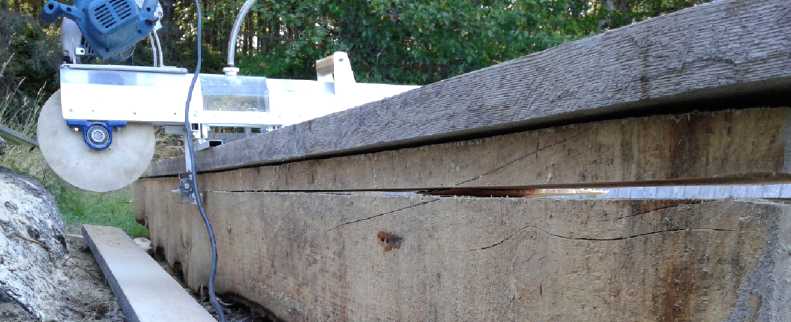 This was
certainly the project of the month. I finally put
in a simple tube with a sponge to wet and cool the band as it went by.
As I surmised by the time I wrote the last newsletter, the self
adjusting band guides system is far superior to any previous bandsaw or
bandmill setup. But this wasn't as immediately demonstrable as
expected. The worst problems I was having were due to a dull and,
worse, unsymmetrically bad band that really wanted to cut circles
rather than straight. Later wavy boards were traceable to bad guide
alignment and then mechanical problems keeping the band from pointing
the direction the guide wheel was aiming it - from two different guide
mechanisms. The second one intended to cure the problem didn't - but
only, as it turned out, because a spring was too light.
This was
certainly the project of the month. I finally put
in a simple tube with a sponge to wet and cool the band as it went by.
As I surmised by the time I wrote the last newsletter, the self
adjusting band guides system is far superior to any previous bandsaw or
bandmill setup. But this wasn't as immediately demonstrable as
expected. The worst problems I was having were due to a dull and,
worse, unsymmetrically bad band that really wanted to cut circles
rather than straight. Later wavy boards were traceable to bad guide
alignment and then mechanical problems keeping the band from pointing
the direction the guide wheel was aiming it - from two different guide
mechanisms. The second one intended to cure the problem didn't - but
only, as it turned out, because a spring was too light.
I continued cutting with both the bandmill and chainsaw
"mini-mill". The boards were good enough for rafters for a lumber
shed... and the cants were sitting where I wanted to make that shed,
and had to go. Cutting them into boards seemed like the best way.
I order some slightly heavier bands, and when they arrived
and a heavier spring was installed, I cut 100 feet of nice straight 6
inch wide boards on the 29th and 30th.
It seemed the bands would need frequent sharpening, but I
finally realized there wasn't enough cooling water coming through the
sponge in the new mechanism and they were overheating when the going
got tough, causing the teeth to lose their tempering and dull quickly.
(Well, duh! I could feel that they were too hot!) A cordless drill (or
'dremmel' tool on slowest speed) with a 1/8" diamond cylinder bit
sharpens pretty fast, but 279 is a lot of teeth, and they don't stay
sharp long if their temper is gone. Maybe I can get a band maker to
produce 2 TPI (or less), .025" thick bands for milling (186 teeth or
fewer).
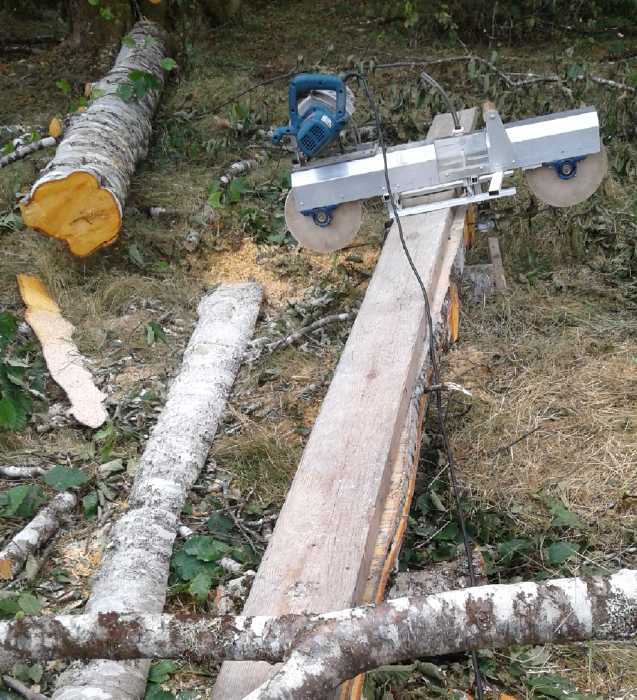 I could see
better ways to do various things with experience as time passed. Some
of them got done. The "skis" that sat on the guide board were changed
to crosswise "skids", a much better arrangement.
I could see
better ways to do various things with experience as time passed. Some
of them got done. The "skis" that sat on the guide board were changed
to crosswise "skids", a much better arrangement.
As I worked through the problems one at a time
results improved. By the time I was on the fifth band it looked like I
might stop wrecking them so swiftly. It was cutting nicely by the end
of the month in spite of still needing a proper band tensioning
mechanism.
By the end of the month I conceived that a "changes and deficiencies"
list was needed for all the little details to apply to a production
model.
Most of the cuts were in spruce and about 6" wide, plus a
few 7-9" mostly in alder.
But on September 3rd I set the width to 13"
and used it to cut up another 10 foot section of alder log in a little
over 2 hours, making ten "perfect" 1 inch thin boards with most cuts
being 8
to 10" wide. (good siding lumber?) With the sponge letting through a
bit
more water, the band never even got warm, and all the cuts went very
well. I was surprised. It was, like... industrial!
The saw will adjust to 18" cut width (potentially 21"),
but I suspect it
will be tough slogging at such widths. Certainly it's perfect
for cutting large cants into boards with almost no waste, and the last
session demonstrated that it can slice up small
whole logs. Cutting large logs into cants is probably still better done
by
chainsaw milling.
Like
the oxalate battery electrolyte, the self adjusting band guides are a
fundamental advance to the state of the art and yet something so simple
that in the future
everyone
will say, "Well obviously. Why would
it have been done any other way?" And yet, for well over a century
before that, since the first batteries and the first bandsaws, everyone
was groping in various directions and no one had a really satisfactory
solution. The electrolyte didn't come to me without a decade of
trying to make better batteries. The band guides inspiration only took
months.
---
I finally sent an e-mail to Swiilawiid on the 17th with a
description of all the things I could talk about if they liked them and
gave me time. The last item on my list is a pitch for a floating
hydro project at the Tlell River, which site I had just
identified as being a good place a week previously. The river is slow
and flat, but near the mouth a lot of water flows both directions at up
to 2 meters per second, in
and out with the tides.
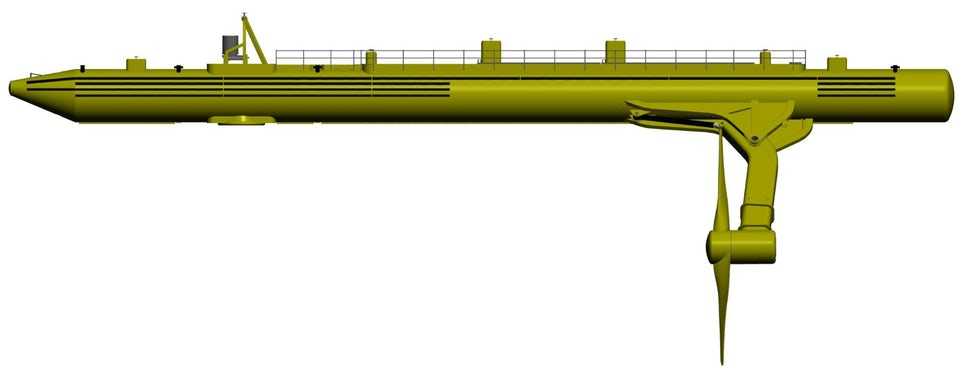 But...
speaking of simple and obvious "why do it any other way?"
designs... on the 22nd a friend sent me a link to a
tidal power project that looked better than all the others and had in
fact made 3 gigawatt-hours of electricity in its first full year of
operation - more than all other previous tide and wave power projects
put together. This seemed very promising. I finally decided that a big
project using that design right in the channel of Masset Sound instead
would be far more worth doing. The design has been proven and it has
the potential to drastically curtail diesel fuel usage on the north
grid of this island.
But...
speaking of simple and obvious "why do it any other way?"
designs... on the 22nd a friend sent me a link to a
tidal power project that looked better than all the others and had in
fact made 3 gigawatt-hours of electricity in its first full year of
operation - more than all other previous tide and wave power projects
put together. This seemed very promising. I finally decided that a big
project using that design right in the channel of Masset Sound instead
would be far more worth doing. The design has been proven and it has
the potential to drastically curtail diesel fuel usage on the north
grid of this island.
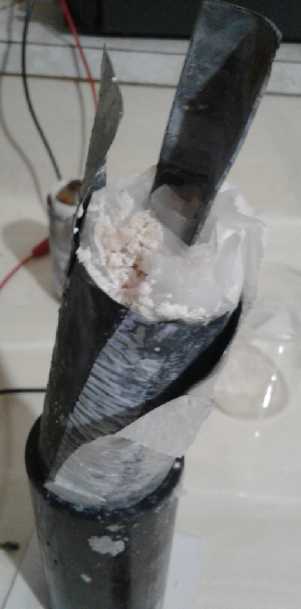 Some people
dropped by looking for advice on batteries, and I decided I
should get back to doing a few more battery experiments. Lots of people
want them and need them, and what's available is either short lived and
very heavy, or very expensive. We need the new types the oxalate
electrolyte enables. A lead-zinc cell with rolled up sheets for
electrodes performed very poorly. While one may perhaps get 5-10% of
theoretical capacity or better out of zinc, it would seem one gets very
little out of a thin sheet of lead. Most materials have to be in
particle form to get enough surface area to be of use. Also it soon
shorted out, and then again, and I decided to give up on thin paper
separators and stick with the more robust liquid filled battery design
with "pocket" type electrodes. But with all the other things to do I
didn't get any further.
Some people
dropped by looking for advice on batteries, and I decided I
should get back to doing a few more battery experiments. Lots of people
want them and need them, and what's available is either short lived and
very heavy, or very expensive. We need the new types the oxalate
electrolyte enables. A lead-zinc cell with rolled up sheets for
electrodes performed very poorly. While one may perhaps get 5-10% of
theoretical capacity or better out of zinc, it would seem one gets very
little out of a thin sheet of lead. Most materials have to be in
particle form to get enough surface area to be of use. Also it soon
shorted out, and then again, and I decided to give up on thin paper
separators and stick with the more robust liquid filled battery design
with "pocket" type electrodes. But with all the other things to do I
didn't get any further.
I reluctantly decided to leave the reluctance motor until
winter. But I decided to plane some of the wavy lumber I'd been
cutting and make a large new workbench in my electronics lab to work
on the motor and controller there. My test equipment and electronics
components for the motor controller are there and it's indoors. And
along those lines, as I perhaps belatedly realized the summer was
drawing to a close, on the 22nd I started in on construction projects
like putting up eavestroughs on the big roof over my travel trailer
(which had been up for a year - took 5 days). The lumber storage shed
was to
be next, but I decided to put it off and use the spare gravel space
under the travel trailer roof for lumber this winter. I could get more
of the
wood cut up instead. and do the bandmill spring tensioning system.
Another two days was consumed shifting things around and moving the
wood, which had been accumulating in an untidy pile.
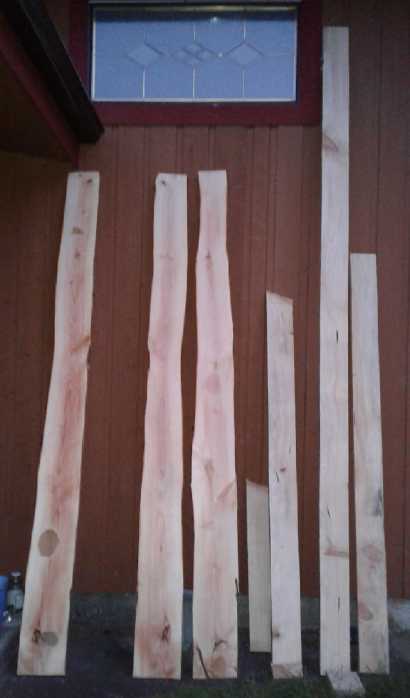 I also planed
a
few boards of alder (for the workbench?) and then a couple of spruce,
after installing a new pair of blades in the planer, which set has
escalated from 40$ to over 100$ in the 10 years since I bought it. The
second spruce board had a broken off screw in it, which wrecked the
brand new
planer blades: now they leave a narrow ridge in the middle of a planed
board. I remember one screw breaking, but I cut the end off that board
- this was a different one I missed or forgot about. That's also what
happened to my last pair
of planer blades - a cut off nail or something when they were almost
new. I can turn them around
and use the second side, but things aren't looking good for making
lumber to sell! I ran a metal detector on a couple of boards I thought
were suspect before
using the bandmill on them, and I think I'd best do the same for
anything I'm going to put through the planer. A bit late tho!
I also planed
a
few boards of alder (for the workbench?) and then a couple of spruce,
after installing a new pair of blades in the planer, which set has
escalated from 40$ to over 100$ in the 10 years since I bought it. The
second spruce board had a broken off screw in it, which wrecked the
brand new
planer blades: now they leave a narrow ridge in the middle of a planed
board. I remember one screw breaking, but I cut the end off that board
- this was a different one I missed or forgot about. That's also what
happened to my last pair
of planer blades - a cut off nail or something when they were almost
new. I can turn them around
and use the second side, but things aren't looking good for making
lumber to sell! I ran a metal detector on a couple of boards I thought
were suspect before
using the bandmill on them, and I think I'd best do the same for
anything I'm going to put through the planer. A bit late tho!
In Passing
(Miscellaneous topics, editorial comments & opinionated rants)
Electromagnetic Induction Arson:
Burning the world!
Note: I thought this would be a
few paragraphs and a few pictures. But
apparently I'm incapable of writing anything briefly to make a point
and it got longer and longer. I hope it's at least a good story.
This is so incredible it's hard to know whether to even
believe what
one sees in the photos in the reports. Unfortunately it's all starting
to form coherent patterns of vast wanton destruction for the purposes
of
sabotage and theft on the grandest scale. It has the appearance of a
plot so twisted
and diabolical that one could hardly invent it for a movie.
In a wildfire the first things to burn are the dry grass
and leaves,
and twigs and branches of trees. All this is the 'kindling' that
spreads the fire.
 A lady in
California brought attention to it on youtube
("intruthbygrace"). In a news
report about "wildfires" she saw on TV, she noticed what most of us
missed: that the
wrong things had burned. An
entire highway crash fence had caught fire, all the posts and the
protruding 6"x8"s that held the metal guard rail, and left the guard
rails lying on the ground at the edge of the highway. (Both sides of
the highway?!?) But the dry grass
and leaves everywhere around it weren't burned, and neither were the
trees nearby. And somewhere a metal
sign had
burned off its two posts, lying on the ground. And
again, the grass, shrubs and bushes near the sign were untouched.
A lady in
California brought attention to it on youtube
("intruthbygrace"). In a news
report about "wildfires" she saw on TV, she noticed what most of us
missed: that the
wrong things had burned. An
entire highway crash fence had caught fire, all the posts and the
protruding 6"x8"s that held the metal guard rail, and left the guard
rails lying on the ground at the edge of the highway. (Both sides of
the highway?!?) But the dry grass
and leaves everywhere around it weren't burned, and neither were the
trees nearby. And somewhere a metal
sign had
burned off its two posts, lying on the ground. And
again, the grass, shrubs and bushes near the sign were untouched.
It takes a long time to burn through heavy posts. They
should be
pretty much the last thing to go in a fire, not the first, kept lit by
the heat around them. But trees are cleared away from the edge of
highways. What lit
them on fire
if even the 'kindling' all around them wasn't burning? And, each post
is
well separated from the others, so what could cause the fire to spread
from post to post with no fire in between posts, to bring down the
entire crash fence? What do the posts have that the grass and leaves
don't have? Seemingly the answer is they have bolts in them, which
could be
heated electromagnetically or by microwaves.
Then other people have
noted trees that seemed to catch
fire from
inside, sparks and flame bursting out from the interior while the bark
is still
hardly touched. Apparently the US government had some bizarre
explanation handy
for that. (Happens all the time... really?) But... burning from the
inside? Aren't microwave ovens
described by the term "cooks from the inside"?
And what about the "fire tornadoes" so many have seen,
wildfires
that burn faster and hotter than any ever before, spreading with
record-breaking rapidity? Lighting up "everything at once" sounds like
the best way to achieve such results, which are reminiscent of the
firebombing of Dresden or Tokyo during the second world war.
And why have there been SO many fires burning all across
the west?
Sure, it's
dry, but it seems nobody knows how most of the fires, at least those in
California, started. They are evidently not mostly lightning strikes.
They are mysteries. But many people have started saying owing to the
suspicious circumstances that they must be being started by some
"directed energy weapon" ("DEW").
 California. What kind of wildfires repeatedly
leap wide paved areas to utterly devastate widely separated buildings,
California. What kind of wildfires repeatedly
leap wide paved areas to utterly devastate widely separated buildings,
while leaving the vegetation seemingly intact? Arson is the word that
comes to mind.
But what kind of arsonist could do so much damage without being
apprehended and stopped, and so fast?
Even before recognizing the suspicious causes and
suspicious nature
of so many of the fires, people had been calling it a "federal land
grab". The US government has seized possession of the burned out areas
as they occur and deemed them federal property, apparently without
even offering
compensation to the owners, who are left homeless or businessless
without a thought as
to their wellbeing. Outright theft!
So there's a motive to explain the bizarre events
behind this bizarre story.
Perhaps some of the huge number of fires in BC as well as
in Washington and Oregon states may be "camouflage" so the huge number
of California fires seems less suspicious, and to keep firefighters too
busy to analyze, seek causes and ask questions.
Fort McMurray, Alberta, May 2016.
Yellow is said to be "hot", white is "still burning".
 Now let us go
back to May 2016. In spite of it being
spring and
probably not too dry, "forest fires" sprung up around the largely new
"tarsands
oil town" of Fort McMurray, Alberta. An infrared satellite image gives
the appearance of the town being very selectively targeted by fire,
does it not?
(According to the description yellow is hot, white (all those houses?)
is still burning.) The fires and heat seem to be all around the town in
a
rectangle.
Nowhere else.
Now let us go
back to May 2016. In spite of it being
spring and
probably not too dry, "forest fires" sprung up around the largely new
"tarsands
oil town" of Fort McMurray, Alberta. An infrared satellite image gives
the appearance of the town being very selectively targeted by fire,
does it not?
(According to the description yellow is hot, white (all those houses?)
is still burning.) The fires and heat seem to be all around the town in
a
rectangle.
Nowhere else.
What happened IN town,
probably
right after the evacuation, appears to defy natural explanation.
Another
youtuber as well
("intruthbygrace" and "PlaneTruth") shows us aerial photos of the town
after the fire. Whole
streets of houses are burned up to a crisp, not even any walls left
standing; no wood left to be seen anywhere. (Even a house that caught
fire in Queen Charlotte this
summer, and then exploded because the owner was storing dynamite and
blasting caps in it, had part of a wall
left standing.) These various streets in "Fort Mac" where everything
was razed
to the ground, are ringed by seemingly untouched trees. And around
those are
other untouched streets with untouched houses. How did the fires get
into
and utterly destroy these various interior streets or even individual
houses, with no apparent fire path or damage around them?
The haste with which everyone was evacuated to distant
points from a fire that was only right around the town seems
reminiscent of some wartime ruse to cause an army to flee without a
fight.

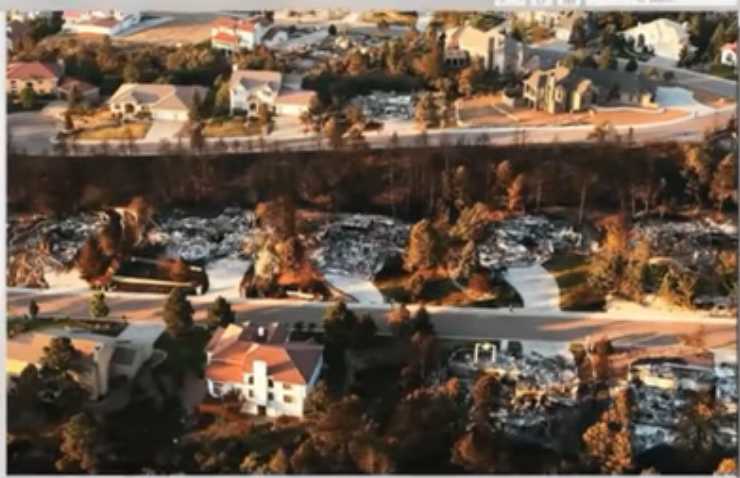 This one looks like it was taken in autumn,
some months after the fire.
This one looks like it was taken in autumn,
some months after the fire.
Still, it doesn't look like the fires did the trees much harm.
 Most of the ash seems to be rings around house
foundations
Most of the ash seems to be rings around house
foundations
 Some trees burned here.
Some trees burned here.
But how did the handful of trees behind the front row torch all those
houses?
Or did the houses burn first?
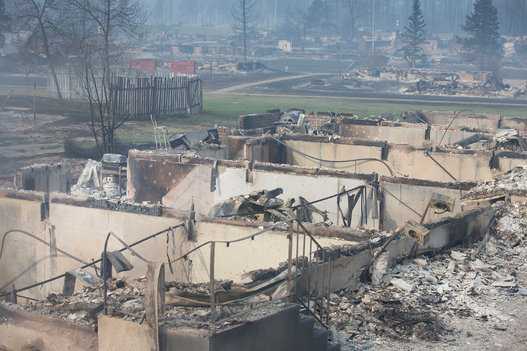
 Masonry and metal: scarcely a board seems to
remain of the houses (here
Masonry and metal: scarcely a board seems to
remain of the houses (here
some townhouses?), while
the trees nearby are untouched or recovered quickly.
Assuming somebody has the means, do we have a motive? The
tar sands
was (and probably again is, at terrible environmental cost) supplying a
lot of crude bituminous petroleum. The price of oil dropped to the
point where all the newly created "fracking" oil seams in the USA were
losing
a lot of money. And so the banks that loaned them billions of dollars
were also
losing.
If a major source of oil like the tarsands could somehow
be shut down without arousing suspicion - or at least without anyone
being able
to point a finger directly at someone - the price of oil would go up
and help
all those banks and rich people with shares in them and in the
"fracking" industry
to make money instead of losing it. What more natural thing could
happen than a big forest fire... which just might happen to pass
through the town where all the workers lived? The timing (Wait... at
the start of May?!?), the location and the rapidity of the spread are
suspicious, and the effects of the - multiple individual fires - inside
and
outside the town
still more so.
There is a revolving door between the big banks in the US and the
government, with things like last year's treasury secretary (or
watchdog over the big banks) becoming next year's Goldman Sachs Bank
chief executive and vice versa. This has been going on ad nauseum for
decades now. And it has been said that there is a new major fraud
averaging every four days on Wall Street. The corruption seems almost
total. But are they really heartless enough to pull such an egregious
caper? They start wars in the name of profits. Did they not blow up the
World Trade Center? This would be nothing to them.
So the next question would be, HOW could this possibly be
being
done? I suspect theories of "directed energy weapons" shooting down
from the sky
might have some problems with physics. There are however
inductively heated cordless kettles and kitchen stoves. They heat
the metal of the bottom of the pot inductively. My theory is that there
is some big truck with powerful electromagnetic, or alternatively
microwave, heating equipment in it. It drives down the highway or
street or trail turning everything metal red hot behind it as it passes
- including
the bolts
in sign posts and guard rail posts, and the nails in house walls. The
wood ignites from the red or even white hot metal embedded in it. Maybe
it's disguised as a fire engine to explain away its otherwise
suspicious presence near fires.
That would describe the nature of the fires pretty well.
In general they happened next to roads. It's easy to visualize a truck
driving
down the highway, turning the bolts and guard rail red hot and thus
lighting up each post of the guard rail as it passes by it.
In Fort McMurray, the patterns of destruction could
indicate that
they drove down some back alleys (a common Alberta municipality layout
feature),
lighting up the homes on both sides of the alley. With red hot nails in
all the
walls, the entire house burns to the ground - no wall left standing and
indeed little wood remaining
because the fire didn't simply progress from where it started to other
parts of the house:
the whole house lit up, and all the houses in quick succession. The
trees around, and the houses across the street, seem untouched or at
least soon recovered because
the "firenado" of the hot, fast fires from the houses sent the most
intense heat upward
into the sky. Apparently they burned too fast to start catching nearby
flammable material on fire. It was only May. The trees were too green
and the houses across the streets were too far away.
We know some fires start naturally or by accident. A quick
question, easy to ask but not easy for me to answer: WHERE
have most of the bizarre looking California fires started? and WHERE
are most of the many
forest fires currently burning in BC starting? Is it near roads or
possible vehicle access points of any sort in most cases? If so, that
would be a smoking gun. But someone has pointed out that the 2018 fires
have been small and numerous, and no one knows how most of them
started. They joined each other to become larger conflagrations as they
grew, there being too many starting too fast to put them all out in
time to stop them.

In the above image from the Fort McMurray fire also, there
appear to be numerous separate small fires upwind of the town rather
than one conflagration spreading through a wide area. Here's a
potential scenario, with Fort McMurray as "practice" before the
California events:
* The above fires might well have been started with incendiaries from
an airplane - this pass south of town and at least one other west of it
per the satellite image quite a way above. Note the nearly straight
line the upwind
points form... as if under a flight path. In this wide country with
hardly any roads it's not likely anyone would be out in the woods and
close enough to witness it.
* The wind blew the smoke over the town and perps went in and said
"It's a big forest fire, moving fast. Everybody has to evacuate."
* The residents evacuated.
* A "fire truck" previously hidden in town in some garage went out in
the deserted streets under cover of the smoke and electromagnetically
lit many houses on fire.
* Some more forests were lit on fire in Alberta and in BC (more
incendiaries?) as
"camouflage" and to keep firefighters busy so they wouldn't have time
to investigate carefully.
I admit that sounds pretty wild. OTOH the whole event just
seemed crazy. Especially in the spring. (Hardly had people started
returning when there were heavy rains and flooding.) And the California
fires are equally bizarre and similar.
I suspect that if you can find the trucks and the weird
equipment they must have - probably including large generators to power
the heating equipment - you'll have found the arsonists. (Or maybe
not... how
to harness HE ray energy has been known to the "deep state" for at
least well over a decade, even if they won't release it to the public,
and
it could explain where the high power that would be needed for this
comes from.)
Finally who could and would be doing it? All I can come up
with is the lawless banks and corporations and the lawless "deep state"
together. Observant people have noted for a decade now that the banks
have gone from being parasites on society to being a terminal cancer.
The government does nothing because the banksters and corporations own
it and control it through deeply woven interconnections. Every year the
crimes and thefts have become more egregious. No one has ever stopped
them, punished them or (better) "dispatched" any of them and they get
bolder
and bolder. These crimes "take the cake" as it were... or is there
worse
to come? (Did you know that with legislation over the last decade
depositors have gone from being the "top of the list" creditors of the
banks to the bottom should the bank have gambled away your money and
become insolvent? All these "zombie banks" are kept afloat by money
printing, fraud and theft. Should any one big bank go under, much less
all of them, deposit insurance plans will be bankrupt. Or the
government will print so much money to cover it that the money will
become worthless, like in Venezuela where today heaps of bills even
with huge
denominations are being tossed into garbage cans for disposal.)
And this is only part of a broader picture. Over the whole
world everyone is starting to sense that something has fundamentally
changed. The sociopaths "at the top" no longer have any regard or
respect for the populations they supposedly lead. Much of the world's
weather is now being controlled artificially. Droughts and floods are
becoming deliberately created phenomena. Since the early HAARP and high
altitude aerosol spraying, weather modification and weather creating
technology has advanced considerably. I'm not even going to touch on
this here except to say that many if not most of the horrible
things we're seeing today appear to be man made - deliberately, but not
with any
coherent overriding plan or theme (or even recognition of cause and
effect) unless it's just to spread chaos and
destruction and kill people in vast numbers. (The increasing
earthquakes (other than those caused by fracking) and volcanoes are no
doubt natural, but somehow fit well into the overall temper of the
times.)
The chief perps think they'll be immune to all this in their bunkers
and
island retreats, but the Most Highs rule in the affairs of men, and it
has been promised that those that remain when the time comes for
cleansing the planet and not reformed themselves by then will all one
way or another be removed from the planet. (That will probably be given
effect to by men, too.) Their callous and wanton
disregard for the lives of others will come back to haunt them. People
will be making decisions in the not distant future that they never
thought
they would have to make, to be a contributing part of the future as the
old
society collapses, or to emotionally and mentally separate themselves
from mankind and live selfishly. Let us pray for everyone and for each
other in this trying time.
I can hardly see all these horrific happenings as being
anything but the death throes of corrupt 20th century civilization.
Obviously with all these weather manipulations, electromagnetic arson,
financial slight of hand and other tricks to try to steal everything
from everyone, it's going to get much worse before it gets better.
For how much longer will orderly commerce for goods and supplies be
available as there's more and more piracy, theft and disruptions? It
would seem to
be appropriate now or soon to get your stored food and supplies
together to
maintain life and limb!
From another even broader perspective, the world is
overpopulated and
this is soon to be corrected. Think of the inequity this way: if the
world has two times too many people, for 1/4 of the population to live
well they need half the resources. The other 3/4 of the population is
then obliged to live on the other half, so they only have - on average
- 1/3 of what is desirable. Only a minority can live well to grow into
their full potential for development. With three times too many people,
then for 1/4 of the population to live well they would consume 3/4 of
the resources and the other 3/4 of this huge population would have to
live on the remaining 1/4, leaving them each with only 11% of what a
good living entails. Since those "with" will have to guard it and
struggle to keep it, and it won't be safe to walk down the street,
really almost no one would have a good quality of life.
Now apply these ratios
to a comfortable 3 billion - versus 6 billion - versus 9 billion - for
a rough estimate of
where we are today at around 7.5 billion, and we see why nearly
everyone is less and less well off with each passing decade as the
population grows, and why millions of refugees are on the move to seek
a
better life or even continuation of life, and why things must soon
collapse. It doesn't excuse
egregious actions against one's fellows, but it does make them more
understandable. Overpopulation is the underlying problem behind all the
other
problems.
When the worst is over, the remaining population, which is
expected to be well under 3 billion or even 2 by 2050, can get on with
building new
and lasting societies based on the core values of life and the enhanced
moralities that will spring from those. [7corevalues.org] The need to
manage
global population will have become abundantly understood by the
discerning majority.
And at some time during all this turmoil, it has been said
that a
new divine son is to
appear. He will not be born a babe like Jesus was but will appear as a
full fledged adult complete with his staff. His divinity will be
readily
apparent
to all who see him. He is to remain on this world for 1000 years to aid
and assist us in helping ourselves, by which time the last vestiges of
the ancient Lucifer rebellion will have been effaced and the planet
brought back into the main stream of universe evolution for the
establishment of the beginnings of the era of light and life.
There are various youtube channels covering the induced
fires and the incredible patents and weather modification machines
created - and deployed - in the past decade. I've only looked at a very
few videos myself. Look them up if you want to know more:
aplanetruth.info - mental_boost - intruthbygrace - neverlosetruth ...
The following quote can perhaps be applied equally to individuals or to
whole societies, at any point in history.
"By their fruits you shall know them. Do men gather grapes from thorns
or figs from thistles? Even so, every good tree brings forth good
fruit, but every corrupt tree bears evil fruit. A good tree cannot
yield evil fruit, neither can a corrupt tree produce good fruit. Every
tree that does not bring forth good fruit is is presently hewn down and
cast into the fire." - Jesus
"By
Prescription Only": Overregulation is Causing Shorter, Less Healthy
Lives
Note: Well, here's another topic that I thought I'd write a few
paragraphs about, and somehow over the month it's turned into a booklet
instead!
Caveat: I've tried to be factual but I didn't have time to
properly research every regulation and every substance in detail. I've
done a lot by memory, and memory is notoriously fickle, especially as
to finer details. Doubtless there are mistakes. The overall deleterious
patterns of authoritarian tyranny as related to this subject are what I
want to show.
---
There are some very good and useful medications out there,
which can be obtained by prescription only. Because of the fact that
they are prescription, you haven't heard of most of them, and there are
probably lots I haven't heard of, either. And for most of them, neither
you nor I can get them - at all - whether or not they would be
beneficial
to us. Your doctor isn't permitted to prescribe them except under
certain conditions for fear of losing their medical license, and that
means some of them are virtually never prescribed. Put simply, they are
banned.
It isn't just you that is being denied freedom of choice, freedom to
use your own best judgment about what might be helpful to you. Even
your doctor has been denied the freedom to evaluate and judge what
might in their patient's best interest. And you thought you lived in a
free country?
DMSO
Take the case of DMSO, dimethyl sulfoxide. [ (CH3)2SO
]
Never
heard of
it? Not a surprise. It's actually a simple solvent, not specifically a
medication at all. Once it could be freely bought and sold. In medical
use,
it seems to cause absorption though the skin of whatever is added to
it. Thus it can be a means to get medications or beneficial substances
into the body via the skin, which can be useful to get specific things
absorbed into specific problem areas rather than just ingesting them, a
route through which it becomes modified through the digestive system
(and perhaps ruined as to therapeutic effect) - and then diffused
through the
body, instead of being concentrated at the problem spot. Astute people
were having good success treating various conditions, especially
certain skin
conditions, that the medical
establishment wasn't doing very well at.
An existing solvent couldn't be patented, and perhaps it
was beneficially replacing some prescription medications(?) The
pharmaceutical companies raised a fuss. When just one person in Ireland
who had
been known to be using DMSO died, from causes which were never
determined much less blamed on the DMSO, it was
seized on as an excuse to make this common solvent available "by
prescription only". (Compare that to 50,000 deaths per year from
acetaminophen ('Tylenol'), by accidental overdose because various
medications with different names contain it, or because it damages the
liver if combined
with alcohol - where are the warnings? Still not "prescription".)
Thus
almost as soon as DMSO was discovered to have medical value it
disappeared from the shelves and, because it isn't specifically a drug
itself and almost no conditions had yet been established for which it
might
be prescribed, it is "by prescription only" yet doctors are not
permitted to prescribe it, even when asked for
it point blank by a patient who knows what they need it for and how to
use it. You can buy any number of harmful solvents, but a rare
one useful to health has been banned. (It occurs to me that perhaps
DMSO
just might hold the key, or part of the key, to healing moles on the
skin.
How will anyone ever find out?)
And you thought you lived in a free country?
Sumatriptan
The variants of sumatriptan - brands Imatrex, Maxalt and
whatever - are the one thing that will take a migraine - that has
perhaps laid someone low with pounding headache and vomiting even for a
whole
day or more - and simply make it go away, or greatly alleviate it, in
an hour or so. I've heard that in Britain and Sweden
it is freely sold on store shelves along with aspirin, advil, tylenol,
ibuprofen etc. Here in North America it is "by prescription only". What
that means is no one hears about it. I even know people here who've
gone to
hospital for help because their migraine is so bad and has
lasted so long - and they still aren't told
about it! They go in there for relief, and are given who knows what
worthless treatment when the whole staff must - surely? - know full
well
what the simple and effective remedy is. (It's also available as an
injection that apparently provides relief in ten minutes! Also note
that the sooner the pill is taken when the headache is coming on, the
less is needed, and that it lasts maybe 12 hours or more, so usually
one dose is all that's needed.) If perchance the staff of this small
town hospital somehow doesn't know there's a remedy for
migraines, how much more does that say the pharmacies should be selling
the medication on the shelves for people to find for themselves instead
of hiding it away?
According to Wikipedia, serotonin levels "often become
extremely erratic" at the onset of a migraine. Sumatriptan "is an
agonist for serotonin which it is structurally similar to", and binding
to it causes constriction of the dilated [inflamed?] cranial and
basilar arteries. (Might we then suspect that the migraine causing
action from migranous foods is to somehow disrupt the normal serotonin
levels in susceptible people?)
I eventually learned that certain foods always (MSG, lemon
peel, yogurt...), and certain other
foods unless they are very fresh (milk [eg, even beyond one
day open in the fridge], chicken...), are the cause of my
migraines. That understanding, which I gained in my 30s, has saved me
from many migraines. Still, eating is still often like 'Russian
roulette', since food
that isn't fresh enough still tastes fine, and unless you made it
yourself at home often you don't know what some of the ingredients
are. (I recently dared to eat some canned chicken. To my relief it was
fine. So gladly I had some from another can of the same chicken with a
somewhat later expiry date. It gave me a doozey of a migraine, which
required way over 100 grams of sumatriptan taken perhaps "not enough
at a time" over quite a few hours to more or less subdue - an
unpleasant day. (At least I wasn't in bed "comatose" for the day like
before sumatriptan.)
Probably the chicken
wasn't fresh that day when it was canned. And I've had migraines from
many canned foods.)
Sumatriptan has been available since 1991 - 27 years. Yet
it seems to
be a well kept secret. The spelling checker here is underlining it and
all of the words related to it. To whose benefit? After too many years
of having too many 'lost' days of serious suffering, my brother gave me
a pill, and said to bite off just 1/3 of it. For the first time, the
vise squeezing my head simply vanished within an hour or so. I don't
know where he found out about it. My doctor
had never told me about it.
Can anyone imagine this senseless lack of information to
migraine sufferers existing if sumatriptan tablets were on the shelves
with the rest of the pain medications? Making it "by prescription only"
has effectively kept it out of the hands of most migraine
sufferers, for whom it is the only remedy so far that has ever really
worked.
And of course one has to make a needless visit to a doctor
each year
to get the prescription, needlessly costing the medical system, and
then pay through the nose - 10 to 20 $ per pill - over 200 $ at a crack
- to get it. It's worth
it if you have a migraine, but I can't help but think that I'm paying a
ransom, and that it must be cheaper in Europe. And surely the makers
there make more money not less because migraine sufferers know what it
is and
can readily buy it when they need it.
And beyond the price, with them being made so hard to get
at the best of times, it's almost impossible to "stock up" on any
prescription medication for times of delivery and
service disruptions. "By prescription only" of almost anything means it
will unavailable and useless to all when hard times are upon us.
Having put aside some emergency food and being on an island where many
seafoods are relatively abundant, it's things like sumatriptan that I
am
most apprehensive about running out of.
Metformin
Metformin was first formulated in about 1920. It was soon
put to
effective use for type 2 diabetes. But in recent decades and especially
in this century quite a few studies have found a surprising number of
other healthful
effects. It's anti obesity, anti Alzheimer, anti cancer,
anti diabetes and a number of other things. Not only can it make older
people
healthier, recent findings have indicated it might extend life even by
up to 40 years, or even 'to age 140'. These estimates by its
enthusiasts may be wildly optimistic. But even if it's only five
or ten years, or even just healthier years, is it not worth taking? If
it was on the store shelves this would become widely known, and it
is plainly obvious that then many people would start living longer and
healthier lives.
None of the usual reasons given for a drug to be "by
prescription" apply to metformin:
- It's cheap, old and well known,
easy to make (in a proper facility, of course).
- It's not dangerous - it has few
and minor side effects if any, especially at the low doses healthy
people might take to get beneficial effects. (eg one 500 mg pill.
People with diabetes commonly take up to four pills, 2000 mg per day.
From what I could find out, potential side effects were 'digestive
upset' and 'gas' -- it sounded about the same as from having a large
bowl of chili.)
- It cannot lead to antibiotic
resistant bacteria or other undesirable long term complications.
- Does no environmental damage.
So it's pretty much like
taking a vitamin. But once again in our "control freak" society, it
can't be had without a prescription - and our doctors aren't
allowed to prescribe it unless you have diabetes. Once it could be
ordered at high cost through the mail from abroad, but now the
company says it can no longer ship drugs to Canada because most of its
shipments are being stopped by customs and returned. The only way to
get any now would be to bum it off a diabetic. And I suppose if a
diabetic were caught taking money from you to recoup his cost,
he would be charged with illegal drug dealing and be
liable to fines or imprisonment. No such thing as it being "between
consenting adults". So here we have something that does no
harm and apparently a lot of good being ruthlessly kept out of
citizens' hands. No amount of effort or money is too great to enforce
each nit-picky little law. It doesn't matter how much harm the law is
doing and that it is doing no one the slightest earthly good.
I complained to my Member of Parliament nearly two years
ago about this, predictably to no effect. I don't think anyone in our
government or even the Canadian government as a whole is actually able
to right wrongs or to undo wrong or obsolete restrictions however
stupid once they have been made. They're not on anybody's agenda, and
nobody feels qualified - or is permitted - to make a new decision
however much sense it seems to make and no matter how long ago, how
uninformed or misinformed or how lacking in perspective the original
decision had been.
And you thought you lived in a free country? It has
become highly dysfunctional and is creepingly more autocratic,
dictatorial and hard to live in every year.
Antipsychotic Medications
Unfortunately there are people born into this world who
develop chemical imbalances that start to affect their brains as they
mature. From what I've seen (and I'm certainly no expert), it often
seems to relate to extraordinary stress when their mother is 4-5 months
pregnant as the brain is developing: eg, serious illness, toxic
relationship with their spouse, and so on.
There are medications to help control the imbalances, and
they are prescription. Perhaps in this case it's best that precautions
be taken, because no one of normal chemical balance should buy and
consume these pills by accident. But being prescription, the patient -
or their caregiver in the more serious cases - isn't permitted to stock
up. This probably causes trouble today, and it's doubtless going to
cause real trouble in times of uncertain
deliveries. There will be people becoming really insane, needlessly.
(Of
course, there will be people going hungry because they haven't stocked
up on food, too. What to do?)
Antibiotics and Nano-Sliver
The argument that antibiotic use should be carefully
controlled so that bacteria don't develop an immunity to them was a
good
one. But there's a huge flaw: Antibiotics are wantonly added to animal
feed from chicken pellets to farm fish feed to prevent epidemics in
overcrowded flocks, herds and schools. This use doubtless far
outweighs all human medical use and tests show that antibiotics have
become ubiquitous in the environment. No, it's not because someone
carelessly
flushed some pills down the toilet! When seen in this context, it might
be understood how little effect making antibiotics for humans
"prescription only" really has had at preventing antibiotic resistant
bacteria from developing. The feed for your chickens is loaded with
those same antibiotics that you have to beg your doctor for a small
bottle of. In some jurisdictions one can freely buy the very same pills
at a pet shop that are impossible to buy to have some on hand from a
pharmacy - to put in your aquarium or give to your dog.
As feared and not surprisingly, bacteria are becoming
resistant to them.
Antibiotics that were once so effective, like penicillin, now are
effective against few diseases and new antibiotics have been rolled
out. But more and more disease organisms are becoming and will become
immune to all of them. The "elephant in the room" of animal feed
antibiotics
overshadows all. Human medical use, underdosage or overuse has
almost no bearing
on the problem. So why not put them on the drug store shelves?
A doctor is likely to know best whether you should take
one, which type is best, the recommended daily dosage and the
number of days for each individual type. But a doctor will have that
knowledge and can make a good recommendation whether the
medication is "prescription only" or "on the shelf". And today many
patients are quite
capable, if they choose, to look on the web and make a reasonably
informed decision for themself, or may have a condition that requires
occasional use with which they are familiar without going to a doctor
each time. Or a
pharmacist might be able to make a recommendation for a particular
common
case without referring to a doctor. They often know more about them
than the doctor. But when it's prescription, the pharmacist can't sell
it (or apparently even suggest it) without a doctor having specifically
prescribed it.
How controlled do we want to be versus how proactive about
our health? Occasional decisions about antibiotics that are less than
optimal would inevitably be made. They are anyway. But at lower overall
cost to every
other patient and to the medical system. I needed antibiotics a year
ago for a tooth infection, but if I
hadn't remembered while in the office from a previous occasion long ago
that
I have a bad allergic reaction to "_cillin" types, the doctor would
have prescribed me one of them. I'd have seen a doctor anyway, but I
suspect the pharmacist could probably have told me a good one to use.
Further, they always say to take the
whole course, but when the problem goes away in a day after one or two
pills, a few more is plenty and it's plainly pointless to take dozens
for another 12 days (or whatever). But the doctor doesn't know because
he's not there. Stopping sooner means less antibiotic use instead of
more. We all have discernment and should be able to take some
reasonable level of
responsibility for our own health if we are pretty sure of what's best.
We are each
ultimately responsible for our own health anyway.
Nano Silver
The decreasing effectiveness of antibiotics brings us to
the antibacterial effects of silver
nano-particles, which hasn't deteriorated over time. It's not that
silver was ever made "prescription" or banned as an antibacterial
agent. It's used in
dressings and bandages for that express purpose. Other than that, it's
simply been forgotten. Back when its use was common, no one understood
what it was doing. Why did babies fed with a silver spoon or drinking
from a silver
cup seem to be healthier than others? Besides magic
or superstition, why did a piece of silver tossed into a cask of
drinking water on a ship make it safer to drink later? No one knew.
"Nano-particles" was not in the vocabulary. Nor was "bacteria".
("Surely
nothing too small to see could affect our health!")
As antibiotics lose their effectiveness, silver will
reclaim
its proper place in health and medicine. Silver, once called "the
devil's metal", is starting to be rediscovered as "the angels' metal"
(which - ahem - doubtless explains its chemical symbol, "Ag" for
"Angelium"). One can buy "colloidal silver" or make it (various
instructions on the web, I'm sure) if one has some pure silver metal --
those same silver coins and bars so many are saying to have in hand for
barter when (not if) the currency of your country hyperinflates or the
banks or government steals your savings from your account(s). (Cypress:
stolen; Venezuela: hyperinflated away; Argentina, Brazil, Turkey:
hyperinflating now. Canada: not
yet; USA: may be last? but will not be excluded.)
Hidden Products - "Shadow Banning"
Then there's rubbing alcohol, isopropyl alcohol, iodine
solution, and model airplane (styrene plastic) cement... sometimes
matches... and who knows
what else? My first experience was being unable to find
model airplane
cement. It seemed that a few foolish kids somewhere had been sniffing
the stuff and doing themselves harm. Instead of asking schools to
educate
about the dangers, the government apparently forced the stores to keep
it behind the counter. What exactly does that mean? Are the stores
supposed to educate the customers or vet them and decide who may buy
it? Is the store
liable if someone buys it, sniffs it and does themself harm? What about
the millions of others, who can't find it when they want it for more
constructive purposes? But at least customers will ask, "How are you
supposed to glue these models together?" - and will presumably be given
the glue. If the clerk knows.
But with that precedent, it seems pharmacies are now
required to
hide a whole host of things behind the counter. I went into a Shoppers
Drug Mart one day to get some iso alcohol. It seemed they were out of
it, as well as rubbing alcohol. Other stuff was in its place on the
shelf. Every time I went back, they still seemed to be out of it. I
finally asked when they would be getting some in, or if for some reason
they didn't sell it any more. They had it, all along! It was behind the
prescriptions counter - for the asking. Later I found the same thing
with iodine solution. And you can't just ask for "iodine": you have to
know it's called "Lugol's solution". They won't tell you. A more
cryptic name can hardly be imagined. (Yes, more than a few drops is
toxic, but a couple a week can be a healthful supplement. That's why
it's added to salt.) Now you have to
know all these things exist, what they're called, and beg for them from
the staff.
And was the point - to make people suspicious? Now I'm
wondering
how many other things are hidden behind the counters, that they can't
sell me or even tell me about unless I know they exist and exactly what
they're called? How
will new things be introduced if no one is permitted to see them?
What this is quite obviously going to cause, quite aside
from aggravation for all, is younger people - meaning all future
generations - aren't ever going to know where to get any of these
things, because they've never seen them for sale. They may have heard
of rubbing alcohol, but they won't know that people still use it. It
will be considered to be something out of old folk medicine, not
something
that might be useful to them. Otherwise it would be available in the
drug store, right? Various things that used to be freely
available on the shelves they will have never heard of. And then the
stores will stop ordering them because no one is buying any.
Effectively, these things are being banned without cause - and surely
without conscious intent to do so.
"You can't cure stupid." is a saying that we might apply
both to those very few individuals who harm themselves with substance
abuse (educate, educate!), and to arbitrary government regulators who
seem rarely to consider the real results to most everyone when they
make some idiotic restrictive law to try to cure stupid with more
stupidity.
"Controlled Substances"
There are other banned or "controlled" substances. I'll
just mention a couple.
Potassium permanganate has long been used by nurses for
skin poultices (I forget what the conditions are for applying it). It
is also used to help remove iron and rust from water in water and
swimming pool systems. I wanted it for new chemistry batteries. Now you
can't get it except at a water treatment
store, and you have to give your name and identification and the reason
you're buying it. Why? Why is every customer a suspect. And of what?
I understand sodium hydroxide ("caustic soda") used to be
readily available at groceries or drug stores. I suppose somebody
decided it was too hazardous to allow the public to have. Now you can
buy sodium hydroxide as various products such as photo developer and
"Easy Off" oven cleaner. But now you don't know it's sodium hydroxide
except by reading the fine print, and then you don't know whether
you're getting pure product or if there are additives, nor how
concentrated it is. It's still just as hazardous. But as long as it
doesn't have a descriptive "chemically" sounding name, it's okay to
sell. You have to go to a "soap making" supply to actually buy the pure
powder, whatever the actual use will be.
When I was growing up a friend of mine got a chemistry
set. His first projects were of course small "pipe bombs", but he was
careful with them, and soon he became quite knowledgeable about
chemical things in practical "how to" terms, well beyond anything
taught in chemistry class in high school.
I [eventually] came up with using potassium oxalate for
battery electrolyte because someone gave me an old kids' chemistry set
in about 2009 (seemingly dating from the same era - late 1960s - the
bottles looked
the same as my friend's) and one of the bottles was oxalic acid. If it
wasn't for that, I doubt if I ever would have looked up "oxalate" and
found that most oxalates including nickel and zinc are insoluble - a
key consideration for a battery electrolyte and evidently almost unique
to oxalate and hydroxide. Today I don't think you
can buy a "chemistry set". I've never seen one for sale. The government
probably doesn't permit them.
How are new generations supposed to get interested in and learn
chemistry? Could lack of overall chemistry perspective be part of the
reason why today most research is focused in the area of lithium
batteries while all other battery chemistry possibilities get
sidetracked or ignored?
Laetrile
Edgar Casey said anyone who would eat two or three almonds
a day need never fear cancer, and that they contained iron and
phosphorus in the right proportions and the most digestible forms to
inhibit tumor growth. "need never fear" is doubtless an overstatement,
but it's perhaps valid if one gets enough sunshine and if the diet is
otherwise healthy, as it commonly was back when that was said. (Pine
nuts
are said to be as good, but I doubt they were being harvested and sold
back then.)
So when I heard about Laetrile, and that it was made from
bitter almond or peach seeds, I wasn't too surprised. In 1830 amygdalin
was isolated from bitter almond seeds,
and it was used as a cancer treatment until the 1920s. The synthesized
version, Laetrile, was patented in 1961.
I remember the furor on American television when Laetrile
was banned in the USA apparently mainly by "big pharma" along with the
government. Their arguments as best I recall were that it hadn't
undergone countless millions of dollars of testing and development like
their products and claims seemed to be unsubstantiated, that
'charlatans' were charging high prices for a "quack" remedy, that one
shouldn't give terminal cancer patients "false hopes", and that it
contained toxic levels of cyanide. (Gee... charging big money... for
giving faint hopes... unhealthy or toxic treatments... that doesn't
sound like established cancer treatments?) But some cancer
patients claimed
that Laetrile had saved their life when they had been written off as
"terminal" by mainstream medicine. I could be wrong, but I pretty
distinctly remember the outlawing as being the spring of 1969 when our
family was in Upland, California. Wikipedia gives a later year for its
banning, 1977. Many individual states reversed the ban, but it seems
it's not legal to transport it across state lines, so no one can open a
factory for wide distribution. Sometimes people with terminal(?) cancer
who still remember about Laetrile go to Mexico to get it.
Since the source apricot, bitter almond or peach seeds and
Laetrile itself contain hydrogen cyanide, Laetrile
is probably in want of further research and development to be safer and
more effective. Meanwhile, have lives have been shortened and sickened
over the
decades by its banning? Has valuable progress and improvements been
stifled? Will we ever find out?
Myself, I prefer the preventions instead of waiting for
cancer to strike. By the time it's diagnosed it's so often already too
late: the daily almonds
without the cyanide, nutritious berries like strawberry jam, and most
of all
vitamin D, which cuts the risk of cancer in half regardless of
getting sunshine - and perhaps more than in half here on the commonly
cloudy
west coast where cancer is so epidemic. I strongly suspect I'd have
been gone 15 or 20 years ago now if I hadn't started daily tanning
through my office window whenever there was sun in the winter (luckily,
it had a
thin old single pane glass window facing south), and later started
taking vitamin D.
Milk
What, how on Earth is milk banned or controlled? It's in
every grocery! But it has been illegal in BC for some decades now to
sell "raw milk" straight from the cow. (In 1972 when we moved to
Vancouver Island we started buying it from someone down the road, but
in that same year the government enforced a stop to it everywhere.
Anyone
with a cow ever since has been forbidden to sell milk to their
neighbors.) Since a cow is a rather large animal that eats a lot and
makes a lot of milk, it's not practical to keep one just to get one's
own family's milk products. (They're also too big to hide from busybody
government regulation enforcers.)
While we all appreciate the safety of
pasteurized milk, is having pasteurization equipment for a cow or even
a herd of
cattle impractical? ...Or is it regulations that make it
impractical or even illegal? (Homogenization is not universally
appreciated for several reasons including that the finely emulsified
fatty particles absorb without being properly processed and cause
calcium buildup in the arteries leading to high blood pressure,
arteriosclerosis and heart disease.) Doubtless many lives and countless
bouts of illness have been saved over the decades by pasteurization.
But another result, as an example, is that
on this rather remote island of 4500 people with not entirely reliable
ferry service even in normal times, there are only a very few dairy
cows, and those are owned by Mennonite farming families for their
own use. This
is probably pretty much true of most of BC. This regulation has taken
all milk production out of everyones' hands and concentrated it into
big conglomerates. There's probably an economy of scale, but it's
ubiquitous just because
it's the only way permitted.
All the milk for the whole province seems to come from a
couple of big dairy plants in the lower mainland and one in Victoria.
(It is impressive - I've toured it.) The dairy farmers all deliver
their raw milk to these plants, so they dairies are concentrated near
them. Thus
in just one more way, money is drained from rural and small communities
into the large cities. With various of these sorts of regulations
blocking small scale rural commerce and production, one starts to
glimpse why there is still an ongoing shift of population from rural to
urban areas and a continuing collapse of small communities.
And of course, all that milk then has to be distributed
from these centers to the rest of the province consuming fossil fuels
in transport. (An article I read says that the average gallon of
American milk travels 320 miles from udder to store shelf.)
There will be no milk products to be had anywhere in the north and
indeed in most of BC in the event of fuel shortages and delivery
disruptions, and the dairy farmers concentrated near the urban areas
will have to slaughter the bulk of their herds while at the same time
there aren't any
dairy cows to be had anywhere else to start local production and new
herds. So at that time yet another ill considered
restrictive regulation intended to improve health in the cities will
severely
contribute to everyones' food problems for an extended period.
Couldn't we create new types of small scale pasteurizing
systems? ...Or is
it that one must perhaps pay for a government inspector to inspect the
plant
daily or frequently, making small scale impractical? I don't know what
the regulations are. Whatever the problem is it
needs to be addressed so some milk production can be
decentralized and moved to local areas where it is consumed.
This topic turned into more research than I had
anticipated - and an unexpected development. Having asked those
questions, I took a look on line and immediately found small scale
pasteurization machines perhaps for a cow or two (3-14 liters per
batch), not very expensive - starting at 440 $US. It lacked
"turbulence" to make sure the milk is all the same temperature, but a
quick stir would cure that, and it came with a thermometer to insert
anywhere. When the heating was done, one runs cold water through the
outer jacket to rapidly cool the milk. [MilkyDay.com] Some of their
more costly ones made cheese and (bletch!) yogurt. I was more puzzled.
What prevents people from getting a cow and a low cost mini pasteurizer
and selling pasteurized milk products?
A further look showed "MilkyDay.com" was in the Czech
republic. A "legal" pasteurizer from the USA started at more like 6000
$ and they rapidly went up from there. They did "dairy herd"
quantities. One site said you could expect to pay 15000 $. An article
about a new one for a dairy herd that was "FDA Approved" ("LiLi") was
70000 $. And they all had temperature chart recorders for which special
paper was required and the charts were "legal documents" for when a
government inspector comes nosing around to check your (one-cow?)
"plant". Yep. That probably explains it. The economical Czech ones
seemed to be the only "kitchen appliance" types suitable for one or a
very few cows. They probably work fine and make the milk as safe as any
other. But they don't record charts and surely aren't "legal" in North
America. 6000+ $ for a way overkill machine makes the entry barrier for
keeping one dairy cow prohibitive. And maybe it needs a government
permit that is priced for a whole herd, too - and possibly may be
available only on a quota system. I didn't delve into these potential
legalities. But I suspect we're not living in a free country.
Thinking of those likely coming supply disruptions I
visited someone with goats. She gave me a liter of raw goat milk. It
seemed quite a lot like cow milk. Apparently it has even more fat.
Later I thought I'd make a small preparation and on the
31st I ordered the 440 $ pasteurizer (another 100 $US shipping). I
don't think I want to look after a cow, or even a goat, at this point.
Maybe a goat at some point. (Feta cheese is great!) In a crisis and if
there's demand I might just buy raw milk and sell pasteurized in the
neighborhood. Or if I don't use it, somebody else doubtless can.
I mentioned it to the lady with the goats and she said
Why? You can pasteurize milk on the stove. On the other hand, she said
she doesn't bother and she doesn't like the taste. I can well imagine
that doing it on the stove it gets a little burned, and it doesn't get
cooled down very fast.
She then went into all the trouble she goes to to make
sure the milk is clean: she throws away the first squirt that comes
out, and is very careful not to let her hands touch the milk as it
comes out. While admiring her care and technique, I began to appreciate
even more the value of pasteurization, with milk collected perhaps less
carefully being implicated in several diseases including tuberculosis.
Is milk pasteurization a main reason there's virtually no tuberculosis
today?
* * *
What's next? Will "big pharma" buy out the borax companies
and remove it from the grocery detergent shelves because it cures
arthritis cheaply, without a prescription? (since the main cause of
arthritis -
and evidently calcium buildup and osteoporosis - is boron deficiency.)
Will somebody figure out how to make vitamin D "by prescription" or get
it hidden behind the counter, unavailable on the
shelves?
You thought the west won the war and we beat the
dictators, and so you live in a
free country? Big Brother is watching over you, in collusion with Big
Pharma and Big Agra, deciding what you should want without asking you,
without allowance for your freedom of choice, geography or other
circumstances and without
bothering much about facts or the real best
interests of citizens!
When things do become a big enough mess and it becomes
apparent that "what is" will have become "what has been" but is now
gone, we'll have the chance to rewrite the playbook in
accord with the morals and ethics that develop out of the underlying
common values all people hold. [7CoreValues.org] I've seen an early
draft for another book by Daniel Raphael beyond Understanding
Social Sustainability
called Restoring the Greatness of Democratic Nations - A Radically
Conservative and Liberal Approach, which when completed should be
of
assistance in coming to grips with these new family, organization and
society building/rebuilding concepts.
Concert
On the 4th, after I posted
the last newsletter, our
band of five the "Huckleberries" played at an outdoor potluck dinner
party. My supercorder had parts in just a few of the songs, but those
were enough for me to have to memorize. People liked hearing
something besides the usual guitars and drums.
Somewhat to my surprise we seemed to be the musical
highlight of the evening and many people got up and danced. All that
rehearsing (with the one hour driving for each, cutting into my project
time) must have paid off. But after playing down on my knees to be by a
mic on
the stage I resolved to bring my own specially configured tiny mic and
amp next time. My supercorder is louder than other recorders; loud
enough without an amp - but not when everybody else is amplified! (For
over a decade now I've always stuffed bits of cotton batten in my ears
when I play, even unamplified, and while I have nasty tinnitus and some
hearing loss - especially from when I was making and tuning
Supercorders - after 40 years in jams, bands and orchestras I don't
need a hearing aid. Not yet, anyway. (unlike our drummer, who is
probably a decade younger than me.))
But later in the month they decided they didn't need a
flute. They were gathering to practice on a moment's notice and that
didn't fit with my 1/2 hour drive into town. And as that took up a
considerable amount of my time I'm just as glad. Time to try something
else, I guess. I bought a keyboard for a pianist to accompany me, and
we had a good playing session...but only one so far.
Democracy
Denied in California
Not long ago, there was a
"state initiative" for something
proposed in California. I forget what it was. To get an initiative - a
citizen proposed referendum - put on the ballot for the next election
in the state, one must get a very large number of signatures -
something like 400,000 in California - in a relatively short time, of
people who think putting it on the ballot is a good idea.
As I recall, it had something to do with health, perhaps
vaccinations, and "big
pharma" didn't like it. After enough people had signed, some of the
signatures were being carried in a government vehicle, from which they
were "lost". Without those signatures, there weren't enough others to
cause the "initiative" to be placed on the ballot - and it wasn't. Somebody
- who but the governor - or perhaps a federal official? (under orders
from whom... president Obama?) - put out the word that some signatures
should vanish. Those in subordinate positions wouldn't take such a risk
to their career. Somewhere, somehow, it was ordered or "authorized"
from "above".
Now someone else sponsored another "initiative", this one
to break California into three states. He spent 1.7 million dollars on
the campaign and got the required signatures. California is certainly a
large and diverse state by US standards, with a population as large as
all of Canada. But the state went to court to have it blocked and a
judge ruled that it couldn't go ahead. It won't be on the next ballot.
Whether it was a good idea or not, I'm not going to venture an opinion.
We'll never find out whether it would have succeeded or been
resoundingly shot down.
In the comments below the article (on Zerohedge.com) some
said the proposed dividing lines were bad. Others said it was a trick
to give California 6 senators instead of 2. Others liked the idea.
Nobody seemed to remember the still recent 'pharma'
affront,
and with only a couple of exceptions, most of the respondents seemed to
be oblivious to a much more fundamental issue: in a democracy the
people are supposed to have the power. The right of people to propose
state
initiatives was established (rightly in my view and the concept needs
to be expanded) and specific terms were set up for citizens to get one
placed on the next state ballot. What an evil thing it is when the will
of the public can be arbitrarily thwarted without even permitting the
vote that has met the state established requirements, just because
present business or politicians don't like it.
It says volumes about the present state of American
democracy, that it can be arbitrarily flung aside without permitting a
vote if it's not expedient or works against some established corporate
interest for the greater public interest. What evil precedents these
set!
These evils aside, the initiative process may be an entry
hook for Social Sustainability Design Teams to start evolving our
stagnant democracies. They might devise and recommend important and
even dramatic changes to the way things work to make conditions more
fair and equitable for everyone.
South Africa:
White farmers want to flee to Russia
 I was optimistic recently when a seemingly changed
attitude by the "leader" of South Africa was reported in a news
article. But apparently
land theft and genocide there was only "off" when he was talking to the
foreign press.
Now 15000 white farmers in South Africa have sent a delegation of 30
families to the mild-climate Stavropol region of Russia to ask if they
can lease some of that 43 million hectares of farmland that Russia has
been offering free to its own citizens and to China, saying it's a
matter of life
and death. They will contribute up to 100000$ per family.
I was optimistic recently when a seemingly changed
attitude by the "leader" of South Africa was reported in a news
article. But apparently
land theft and genocide there was only "off" when he was talking to the
foreign press.
Now 15000 white farmers in South Africa have sent a delegation of 30
families to the mild-climate Stavropol region of Russia to ask if they
can lease some of that 43 million hectares of farmland that Russia has
been offering free to its own citizens and to China, saying it's a
matter of life
and death. They will contribute up to 100000$ per family.
They are being murdered at a high rate, and complain that
the government of racist Cyril Ramaphosa is egging the violence on and
avowedly intends to expropriate (steal) all their land and "return" it
to "the black citizens" of South Africa. (The white people now aren't
even citizens?!? And do recall there were no blacks in the Cape of Good
Hope
area when white farmers started settling it, and only nomadic tribes in
other areas. The Hottentots are gone. So to whom is the land being
"returned"? But first the
whites took black slaves, and then the nation and its opportunities
attracted more and more people from the primitive surrounding regions.
Blacks became a rapidly growing segment of the population and are now
the great majority in most areas.) Irrigating and managing these farms,
many of which were just desert or scrub before the Boers came,
isn't trivial. One suspects that for every farm there are a dozen
farmhands, mostly black, who will lose their jobs. If the bigots
continue to oppress, murder and
drive out their experienced and capable farmers, will South Africa not
starve, and sink into primitive barbarism like its neighbors? That's
what happened next door in Zimbabwe (AKA Rhodesia).
Apparently there have been some positive social and family
developments in South Africa too, but it seems even many Zulus (black)
are already saying
things were better under apartheid.
More Hypocrisy
from the Main Stream Media (MSM) & Extension of Censorship
The MSM got together and
got 300 news outlets to write or
air editorials to decry that president Trump has been calling them
"fake news"
and is therefor a danger to democracy for not letting "independent
journalists" have open access to his white house.
Where have they been all this time while those of their
own - those who they claim to be - need them to help expose threats and
sabotage to the free press? Why do they never stick up for them? Where
were they when reporter Michael Hastings was murdered (by a
sophisticated job of sabotaging his car [2012? or was it later?]) when
he was about to
release "an exposé" on the CIA? Where have they been all these
years
that journalist Julian Assange has been a fugitive in the Ecuadorian
embassy in London because their government would like to capture him
and throw
away the key because Wikileaks printed true facts that were
uncomplimentary to the US government? I remember a government spokesman
(Comey?) on TV before Assange went into refuge. There was no hint of
statesmanship or reasonableness or justification, it just sounded like
"We're the toughest bullies in the playground. We'll find you wherever
you go and we'll get our revenge on you for telling on us!"
(Their misdeeds they never tried to deny). I was incensed at his gall!
(Then there's Hillary "can't we just drone strike him?" Clinton, who
leaves a highly suspicious trail of actual bodies of her opponents
wherever she goes. Where's the reporting on that... oh, wait: several
witnesses
and probably some reporters' bodies are in that tally too.) Where have
they been while
various reporters around the globe have been threatened, imprisoned or
murdered for investigating, publishing or unearthing inconvenient
truths? Why do
hardly
any of these outrages ever appear in the mainstream western news, only
on the internet?
Where are the scathing TV editorials about those threats to democracy?
Don't the mainstream "journalists" care in the least about "their own"?
And the war against real independent
reporting and journalism has been extended this month. Perhaps you've
heard that Alex Jones and Infowars[.com] were simultaneously expelled
from facebook, youtube, google and other "independent" social media
channels. This was obviously centrally planned in collusion. But
simultaneously various other bannings also took place, so that while
everyone's attention was focused on the high-profile Alex Jones, the
rest would go unnoticed
and unreported.
And then there's "shadow bannings" that simply pretend
everything's normal while not transmitting the messages by the unloved
groups - or perhaps messages with words or phrases that their systems
have flagged - to their intended audiences. For example, "tweets" that
don't actually go out to the person's followers, youtube news videos
and news and journalism channels that never show up except in the most
explicit of searches for their name, and so on.
And through all this unpredictable and heavy handed
treatment,
they are trying to get people to "self censor". "I don't want my
youtube news/interviews/talk channel with 200,000 subscribers to be
unexpectedly deleted, so I won't say what I really want to say about...
all sorts of things." Shades of "1984"! Channel "FullSpectrumSurvival"
had an excellent show "News in Two Minutes", covering all sorts of
major happenings in the world in incredible brevity, which seems to
have quietly disappeared. The owner, Brad, said they had to tow the
line or be removed from youtube. How valuable is being on youtube if
you can only stay by canceling your main show? And where else can you
go besides youtube? No one would know where to look for you.
Someone recently pointed out that banning people who "the
establishment" doesn't like on social media amounts to denying "freedom
of assembly", a right guaranteed by the US constitution's first
amendment. Censorship is alive and well in North America! It is not yet
standing gloating over the corpse of freedom of speech, but it is
dealing it crippling blows.
Big Oil
Subsidies
There's been a Google ad
appearing titled "Dumb Energy"
that asserts solar and wind power are "heavily subsidized" and don't
produce much power. By omission big oil isn't subsidized - Hah!
'Fraid I didn't click on it. The Canadian government
is spending 4.5 billion dollars of
taxpayers' money to build another oil pipeline -- seven times as much
money as the world's biggest solar panel power plant (679 million $).
A pipeline will produce no energy at all. How much better off would
we be if 4.5 billion dollars was used to
build seven more of those electricity producing solar plants instead,
which would
soon pay back the entire investment via electricity revenues? (Also,
how much more electricity would they produce than the Peace River "Site
C" dam power project at twice the cost, 10 billion?)
---
Underdog Humor
Changing Language...
Politically Correct?: When Obama was president, shouldn't his
headquarters have been called the Black House?
Once severely mentally subnormal people were called "imbeciles".
Someone decided that was mean, so they insisted it was kinder to call
them "retarded" - delayed or behind, with the implication that they
might some day catch up. Then someone decided calling them "retarded"
was mean because that word had acquired quite a negative connotation
that it hadn't previously had. So they decided they should be called
"mentally challenged" or some such term. Is it not obvious that
whatever term is used will take on a negative connotation because of
the unfortunate caste of beings it's being used to describe? If we
called them "geniuses", pretty soon that word would be considered
derisive, even offensive.
And who now would use the term "gay" to describe a happy and festive
atmosphere or person? Ever since about 1972 when someone used it to
describe something else entirely its meaning was instantly and
completely changed. Using it in its original sense would almost
certainly be misinterpreted, and it is now jarring to hear it used that
way in old movies.
Segue?
Once the darkest skinned peoples were called "negros". "Negro" is
Spanish for "black". Suddenly someone decided "negro" was derogatory
and they should be called "black" instead. Clearly this is prejudice
against Mexicans. Perhaps we can find a more neutral term. How about
"Albedo challenged people"?
All Well and Good:
My dog is weller than your dog. - in better health
My dog is gooder than your dog. - more altruistic
My dog is better than your dog. - knows more tricks
My dog is finer than your dog. - more dainty; high strung
My dog is a better better than your dog. - Lucky you, yours doesn't
gamble!
My dog is a finer Wellerer than your dog. - I'll bet yours doesn't do
any soldering at all
My dog is a gooder finer than your dog. - As a police dog he rightfully
writes
many tickets
Antacid: what those nasty red "fire ants" squirt up at you if you
disturb
their hill.
"in depth reports" for
each project are below. I hope they may be useful to anyone who wants
to get
into a similar project, to glean ideas for how something
might be done, as well as things that might have been tried or thought
of... and even of how not to do something - why it didn't
work or proved impractical. Sometimes they set out inventive thoughts
almost as they occur - and are the actual organization and elaboration
in
writing of
those thoughts. They are thus partly a diary and are not
extensively proof-read for literary perfection and consistency before
publication. I hope they add to the body of wisdom for other
researchers and developers to help them find more productive paths and
avoid potential pitfalls.
Electric Transport
Jim
Harrington's 2.5 HP Electric Outboard
While my Electric Caik outboard has sat idle the whole
summer, Jim Harrington has reworked a couple of his electric outboard
projects. While my focus has been on inventing new things that are
hopefully better than what is presently available, Jim has a more
pragmatic approach of using as many "off the shelf" components as
possible to get more immediate working results. This one, now
transferred to this tunnel hull skiff, has worked well for some years.
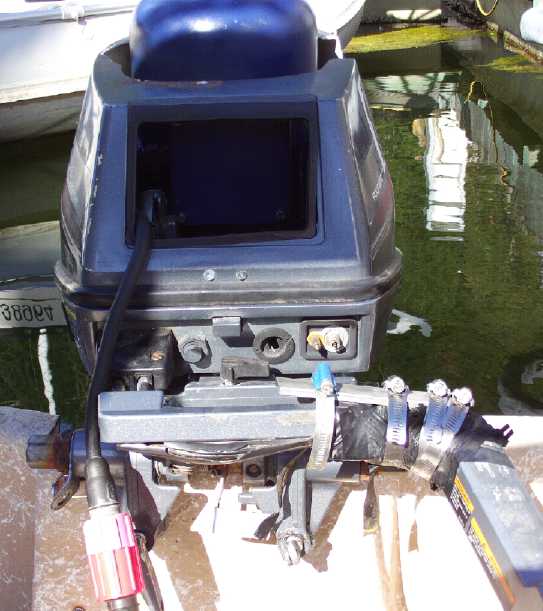 2.5 HP, 230 volt induction motor installed in
Yamaha 9.9 HP outboard leg.
2.5 HP, 230 volt induction motor installed in
Yamaha 9.9 HP outboard leg.
The 3-phase vector (frequency) drive is able to produce up to 120 Hz
instead
of just 60 Hz, so the 1750 RPM motor is able to deliver 3500 RPM
instead,
compensating for the inevitable gearing down of the speed down at the
propeller shaft which is appropriate for gasoline engines.
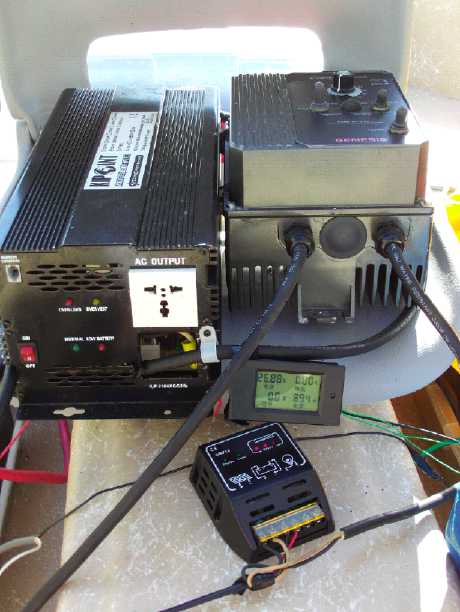 24 volt batteries are changed to 230 volts AC
with an inverter (left)
24 volt batteries are changed to 230 volts AC
with an inverter (left)
The vector drive (right) puts out the 230 volts as 3 phase power at
variable frequency for the 3 phase induction motor outboard.
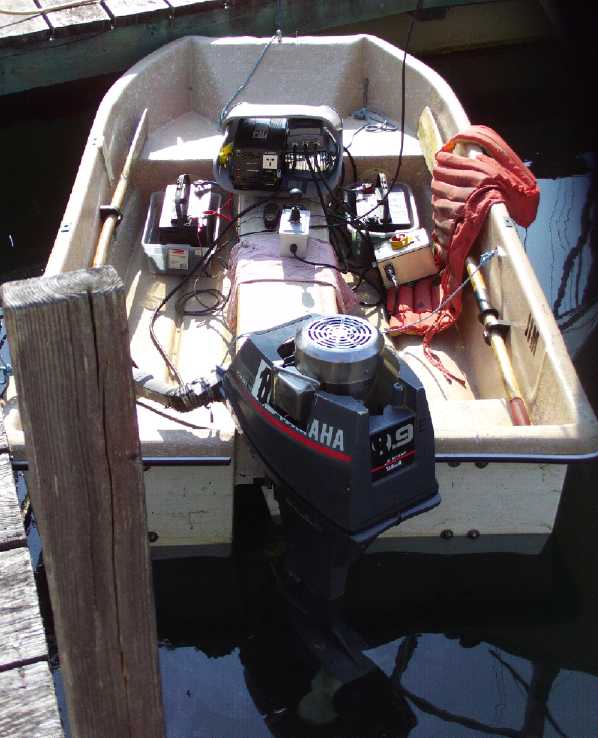
With a "rule of thumb" ratio of about 2.5 to 1,
a 2.5 HP electric will get the boat moving similar to around a 6.25 HP
gas engine.
Other "Green" Electric Equipment Projects
Carmichael
Mill ("Bandsaw Alaska Mill")
There's a lot of "blah blah
blah" fine detail here and it's something of a log of my log cutting.
The short version is above, in month in brief.
"New" Blade & Tests
On the 5th I took off the dull band and put on
the sharpest one. Then I spent the better part of an hour adjusting the
tracking and tension. (I wasn't going to change it until the saw had
the blade protector and cooling water feeder - now done; just a plastic
pipe with a sponge.) Then I took
the saw out to the wood. It
cut very slowly. I stopped after 2 inches, and after a few seconds
remembered that I
was supposed to turn the band inside out. The teeth were in the right
place but pointing the wrong direction. So I took it back in, took it
off and did it over again.
This time it cut well. Part way along I stopped, stuck in
a wedge to expand the thin cut in order to see it well, and
checked everything. The sides of the cut were in the right place and
straight, with the guides level. And I could see light through the
crack, which meant the cut was straight inside.
Cutting speed in the 6 inch wide piece seemed to be
just under an inch per second or 5 feet per minute. That seemed a
little slow, but not bad. (I remember getting 6 or 7 FPM in some
earlier tests. This time it just didn't seem to want to go quite that
fast. None of my bands were new now. Then again, I had changed the
pulley and the band wasn't spinning quite as fast. Could that be it?
Perhaps I should speed it up again?)
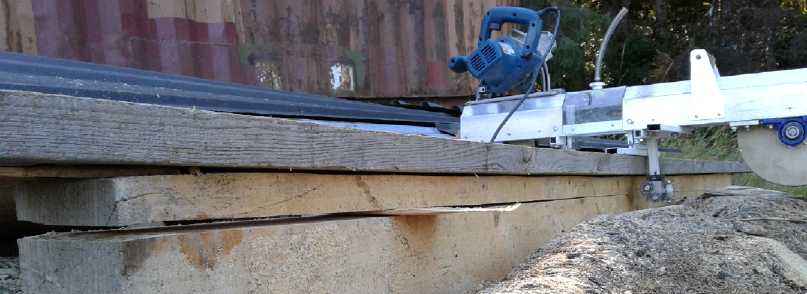 Cut was flat and straight - Yay!
Cut was flat and straight - Yay!

When I got to the end and looked at
the board, it was probably about as straight as the guide board had
been. There was no bow across it; it was flat. There were a few small
wobbles on the entry side, where the imbalance
made it easy to lift the skid above the board momentarily. The exit
side cut line was quite
straight. And the remaining cant of wood underneath looked pretty flat
on top.
With good results now (at last!) shown in a 6" wide cut,
further tests should include wider boards, starting with a couple of 8"
wide cants I made last fall. Whether to go up to the max the saw can be
set to, which is now about 18" as configured, will depend on how well
it does as width is increased.
Even if it only does 8" well, having cut successfully
without notable glitches, and with there being nothing one needs to
keep stopping and adjusting like on other band mills, I think I'll be
cutting up my spruce over the rest of the summer.
Later I did notice some sawdust build-up on the blade, the
driven wheel, and even some on the grooved guide wheels. Sticky stuff,
that spruce sap, and the cooling water may be making it worse. I
wouldn't
have expected it to stick to the stainless steel band. It'll be
annoying if I have to stop and scrape it off every 2 or 3 or 4 boards.
(Turpentine seemed to help.)
On the 6th I naturally expected more good results. But a
bearing on one guide wheel seemed to be seized, so I replaced it and
while I was at it made some tracking adjustments. I took the saw out
and a clock that showed seconds, and started cutting, intending to time
how long it took to cut a 12' board. I had a vague impression it was
going a little slower. Then near the end the cut line went off kilter,
veering down. I backed it up and tried again, but results were poor. I
finally checked the band and it was loose. It had no tension to speak
of. I had neglected to retighten a couple of nuts in the tracking
adjustments, and something had shifted. (Another "little job, before
breakfast" gone wrong!) When I finished the board, I could see it had
started to bow down inside the cut after the first couple of feet.
(opposite to the previous band.) Funny it did as well as it did. Vexing
yes, but I was mostly just relieved it wasn't some design problem I'd
overlooked!
Well, that thought was apparently a little hasty. I
tightened the band some, but the next board didn't go much better. At
points the band seemed looser in spite of being kept pretty cool, and
it cut way off at the same place - there was a knot there. The whole
board, or most of it, was again bowed downward.
I started to think that one more thing was needed for a
trouble free mill: self adjusting band tension to keep it at the
optimal amount. My shop bandsaw had a heavy spring pushing the top
wheel up to keep the tension at the set level. The wheel was free to
move up and down in a channel, but staying in alignment as it moved. I
hadn't realized how important it was that it be done with a spring.
Metal bands stretch and shrink with heat and that changes their length
more substantially than I had realized until confronted with
ever-changing band tension.
My wheel's bearings were bolted to the backbone of the
saw. Just as when I first built it, making the wheel adjustable looked
like a hard thing to do on my saw. But now I realized it was vital.
One invented design feature improving the whole
of bandsaw technology, one overlooked design feature making it worse!
Wide Bandgap - guide aims up
but band kept veering down
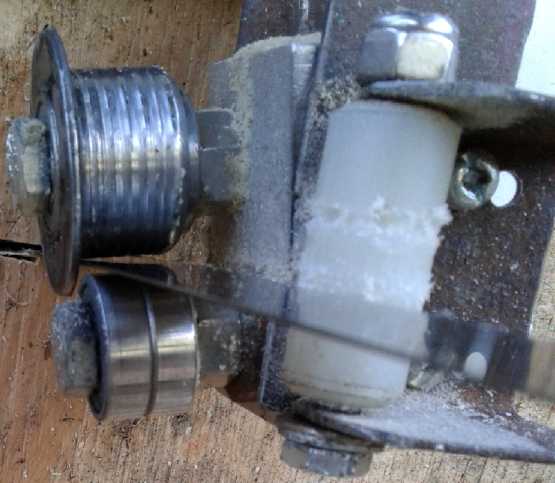 I did some more cutting on the 7th. I noticed that if the
band veered down much, a gap opened up between the upper and lower
guide wheels on the entry side, so the band wasn't being held at the
angle of the wheels. This allowed it to continue cutting downward,
apparently explaining the bowed down and wavy boards. Perhaps having
the upper and lower wheels offset was a disadvantage after all.
I did some more cutting on the 7th. I noticed that if the
band veered down much, a gap opened up between the upper and lower
guide wheels on the entry side, so the band wasn't being held at the
angle of the wheels. This allowed it to continue cutting downward,
apparently explaining the bowed down and wavy boards. Perhaps having
the upper and lower wheels offset was a disadvantage after all.
When I ran out of the cant I'd been cutting through I got
out the
"mini mill" I'd bought. It ran along a guide board on top of a log and
the attached chainsaw made vertical cuts. I couldn't see how to put the
big chainsaw on it for the small cut without it sticking way up in the
air and only cutting with the lower end of the 30" bar. So I used my
small gasoline chainsaw instead, to split an 8 foot long "half-round"
into two quarters. (actually about 2/5 and 3/5 widths.) The cut depth
was 8 to 11" - maybe 1.5 times wider than the 6" boards. I got the
impression I was cutting about 15 inches per minute. If the bandmill
had been running well with no problems and could have done that cut,
the chainsaw mill didn't compare very well with what might have been 35
to 45 inches per minute: it was under 1/2 the speed using twice the
power and it made a lot of sawdust and noise - and used up pricey
gasoline. Of course, the piece was too wide for the band mill and the
1/2 log was more or less too heavy to turn sideways to do a different
way until it was cut, so the mini mill filled the gap. Then I cut two
8' x 2" x 7" wavy boards from the 2/5 side with the band mill, cut the
remnant into firewood, and that was a day.
But I didn't let it end without considering how I might do
a spring loaded band tensioner. With the wheel held by bearings on both
sides instead of cantilevered out from one side, the way it's done on
most bandsaws wouldn't work. But the extruded aluminum tubes of the
saw's "backbone" had a hollow part, about .5" by .75". I couldn't find
any steel tubes that fit it, but I had some .5" solid aluminum that
would go right in if it was cut to width. That could make two sliding
bars sticking out from the end, and the wheel bearings could be
attached to them. Then the wheel could slide in and out. Two springs
down at the axle level would tension it.
The other option might be to change everything to the
cantilevered axle and bearings. I think I'd have to redo the whole end
of the saw and make a whole sliding assembly, similar to typical
bandsaws, to hold it.
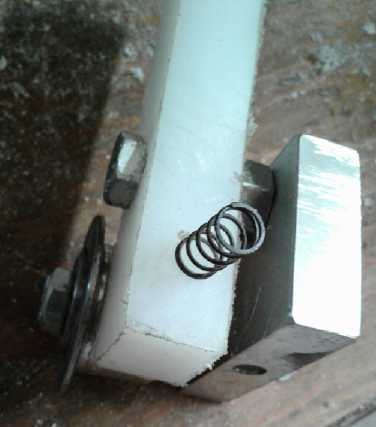 By the next
morning (8th) I had figured out that I wanted
to make a spring-loaded UHMW plastic slide to replace the bottom guide
wheel, at least on the intake side. As it wore the spring would keep
pressing it against the wheel, so it should last quite a while unless
it wore quite unevenly. I could have it pivot on the same mounting bolt
the lower wheel had used. The one thing I wasn't sure of was how and
where to put in a spring. But I cut and drilled a piece of plastic and
when I had it mounted on the bolt a simple plan occurred to me. Somehow
I found the perfect spring in my springs drawer. (It was actually too
weak and I had to replace it.)
By the next
morning (8th) I had figured out that I wanted
to make a spring-loaded UHMW plastic slide to replace the bottom guide
wheel, at least on the intake side. As it wore the spring would keep
pressing it against the wheel, so it should last quite a while unless
it wore quite unevenly. I could have it pivot on the same mounting bolt
the lower wheel had used. The one thing I wasn't sure of was how and
where to put in a spring. But I cut and drilled a piece of plastic and
when I had it mounted on the bolt a simple plan occurred to me. Somehow
I found the perfect spring in my springs drawer. (It was actually too
weak and I had to replace it.)
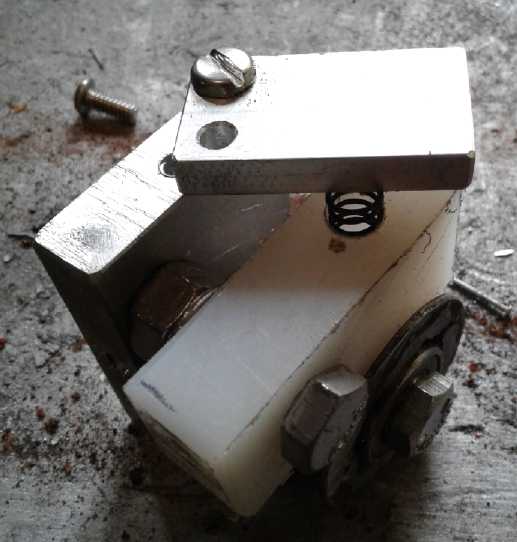 It went into a hole in
the plastic. Then all I had to make was a bottom plate for it to press
against. I had it all done in about an hour and a half; time well spent
if the boards came out better. (Except for having started again without
having breakfast first, or even coffee. Why do I do that?)
Unfortunately, good as it might be, this didn't seem to address the
problem of why it wanted to veer downward to start with. Was this band
too dull or off-center?
It went into a hole in
the plastic. Then all I had to make was a bottom plate for it to press
against. I had it all done in about an hour and a half; time well spent
if the boards came out better. (Except for having started again without
having breakfast first, or even coffee. Why do I do that?)
Unfortunately, good as it might be, this didn't seem to address the
problem of why it wanted to veer downward to start with. Was this band
too dull or off-center?
I also figured out that the easiest way to spring-load the
undriven end wheel was probably to replace the pillow block bearings
with ones I made myself, but to make them with springs to push the
bearings themselves toward one end. For this I would probably use 1/2"
aluminum and ball bearing races a little less than 1/2" wide. (Thicker
aluminum would be better but that was my heaviest.) Side walls of
thinner aluminum would keep them in place. But one change was enough
for one day.
I did some more cutting with the chainsaw mini-mill, then
tried to cut an 8" wide board from a thicker piece with the bandmill.
The right side again started veering down, and it quickly became hard
going. I stopped and examined the saw again. The band seemed to be
pretty sharp with okay set to the teeth. Then I lined up carefully. I
thought I had got the band right in line with the pivot pins, but now
that didn't seem to be the case with the right guide. The band was
slightly below the center of the pin, so there was a downward force on
the band when it was straight and level. Surely that was the source of
the problem.
How to fix it? Other than make a whole new guide block, I
could turn the wheel a little smaller. Then the band would line up. I
decided that was the simplest path and I did it on the morning of the
9th.
But when I started cutting, it didn't seem much different.
What, what, what was causing it to veer down on the right, blade entry,
side? Also of note, 8" wide cuts seemed 3 times as hard as 6". For the
first time,
the Ryobi saw motor started to smell too hot. I tightened the band
tension a
couple of notches. It may have been a bit better. After a while I did a
couple more notches. Then a couple more. The twang was getting well
into the treble clef. It did seem to help. Sometimes it seemed to help
if I pushed down on the handle at the back of the saw, or lifted the
right side a bit. But why? With the guide wheel trimmed down and lots
of tension, occasionally, things went just right for a moment. The
motor would speed up and sound free instead of labored, and the mill
would suddenly charge through 6 or 8" of wood in a few seconds.
Usually where there was a good size knot. And there would be no bow
across the board just in those areas. Why didn't it cut like that
everywhere, all the time? Was the grain of the spruce somehow messing
things up? Just how much tension did one want on the band, anyway? And
how much could the components of the saw take without bending, warping
or breaking?
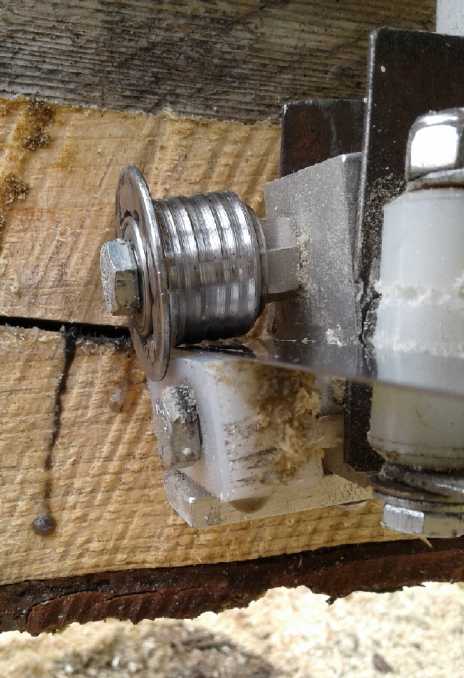 It wasn't easy
to see much of the mechanism when cutting.
My head was usually over top of the saw. To see the offending guide
wheel I would have to "duck down" some and get my head behind the saw
while pushing it. I started to think I had the clear plastic top
cover/guard in the wrong place. The clear tube showed if there was
cooling water. The clear cover should be over the guide wheel to see it
while cutting. And anyway the cooling would go with it. With all the
trouble, I decided to move it there. It would be valuable to see if or
when the cut was starting to go off course. And maybe I'd see something
that would help explain things.
It wasn't easy
to see much of the mechanism when cutting.
My head was usually over top of the saw. To see the offending guide
wheel I would have to "duck down" some and get my head behind the saw
while pushing it. I started to think I had the clear plastic top
cover/guard in the wrong place. The clear tube showed if there was
cooling water. The clear cover should be over the guide wheel to see it
while cutting. And anyway the cooling would go with it. With all the
trouble, I decided to move it there. It would be valuable to see if or
when the cut was starting to go off course. And maybe I'd see something
that would help explain things.
I returned to cutting the next day, starting with some
chainsaw milling to turn a wide slab into 6" wide pieces. For the
bandmill I tried putting in washers to raise the front of the saw a
bit, since pushing down on the back had seemed vaguely to help. But I
didn't really see how that could help when the band guides aimed
themselves, and it didn't. Later I went out and cut one more board. I
twisted the saw back and forth and that seemed to help keep it cutting
fairly quickly with somewhat less friction. But that was supposed to be
my strategy for cutting 18" wide, not 6"!
But also, this time when I checked the band for heat, I
"twanged" it. It was a pretty low pitch. I tried again in a few (10?)
seconds, and the pitch had gone up (a minor third?). Another short wait
and it had gone up some more. And then another semitone. It might have
been a fourth or a fifth overall. Even though it wasn't overly hot the
first time, the tension obviously changed fairly drastically with band
temperature. Then I kept stopping and testing it to make sure it didn't
get loose again. And again each time I waited a bit, the pitch would
rise, usually just by a semitone or two. The board had slight waves in
it and some convexity across, but the only one big wave was probably
where I had first stopped and found the tension way down. (And what was
with the straightening out wherever there was a large knot? Was the
grain of the spruce a big factor dragging it off? It would be nice to
have some other type of wood to try cutting.)
The twang test settled it. The tensioning mechanism with
springs had to be made next! Having the tension get slacker and slacker
as the cut went along was obviously part of the problem. With the slow
cutting and the stopping, it was taking over 10 minutes for a 10' board
just 6" wide. I feel it should take about 2 minutes if everything is
working perfectly - or less.
But the next few days were rather busy and all I manged to
get done was some little thing and a test cut each day. I thought I'd
see if I could pick up some test piece(s) of any other species besides
spruce. I drove to Port Clements but nobody seemed to be around. All
this slow, hard cutting kept saying that whatever its appearance, the
band must be dull. I got home and tried sharpening just the top-offset
teeth of the band, since it always seemed to be veering downward. I
found a 1/8" diamond cylinder bit for the 'dremmel'. (I guess I bought
that set of bits for a reason after all!) It seemed as close as
anything to the face shape of the teeth, and I used it, on the lowest
speed.
The blade zipped through the first foot of a board,
straight and easily in less than 10 seconds, reminding me of when the
blades were new. Wow! Then it hit a knot and things went right downhill
again. It reminded me of the first time I had sharpened a bandsaw band
over a decade ago. That one cut great for 1/2 an inch into a piece of
rosewood and then just burned. Apparently the high speed dremmel had
heated the teeth up and they lost their temper, so they dulled almost
at once in the hard wood. But this time I had had the 'dremmel' on the
lowest speed and kept the sharpening time minimal. Perhaps I should try
again with the drill press, on its lowest (even lower) speed? That's
what worked in 2007. Or the slow cordless drill?
On the 13th I cut down an alder tree, about 12-14" across
at the base, to have a couple of test logs to saw other than spruce.
(There are hundreds of alders on my acreage. This was one of a patch
that
had grown up and shaded the original garden area, making it useless...
maybe potatoes if I restored the fence to keep the deer out.) I had to
cut a couple of small
ones hard by it first before getting to the main event. Then I cut an
awful lot of branches to firewood length, and that wasn't half of them.
That was all I got done that day. Silly me... I was
sometime in there idly wondering how I would move the logs to where I'd
been milling. But wait! The whole reason for a handheld mill was to
bring it to the log instead of vise versa. I put the saws and tools in
the back of the Miles electric truck to bring them to and from the work
site.
On the 14th I cut off a
slice for a test cut in a narrower
piece of the alder from higher up, about 8' long. It seemed to cut more
easily than the spruce, but it still felt like the blade was dull. The
cut was straighter but not straight, but it might have been more the
cut depth guides weren't fitting on very well the guide board - the log
was a little wider and I had to adjust the width and then make a couple
of chainsaw cuts. The "stainless steel" band left all kinds of black
marks on this 'green' wood, which showed where it rubbed. It was still
the lower piece at each side, and the top one inside in the middle, the
cut "bowed down", except there was less bow than in the spruce. not to
say none.
The more I cut, the more I see it needs (a) the typical
alaska mill cut side-to-side depth glides, (b) the spring tensioned
undriven wheel, (c) the transparent piece of top guard moved over the
leading band guide and (d) the sponge cleaned out already in the water
cooling. (or something. The water feed has slowed right down.)
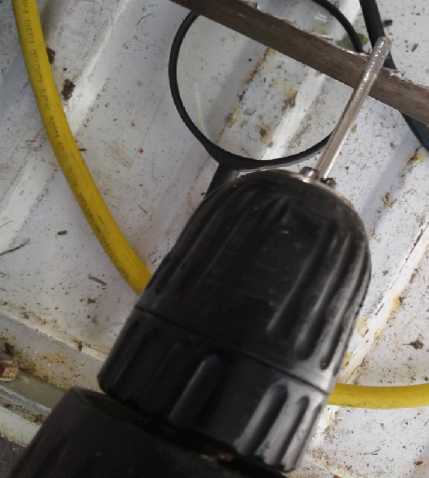 15th: I sharpened the blade
using the diamond cylinder but in the
cordless drill at slow speeds instead of in the 'dremmel'. Then I
rubbed a candle on the band to wax it, which is an old sawing trick to
reduce blade friction that I suddenly remembered. It felt sharper
running my finger along it. I cut a board from the log. At first, where
the log was around 6" wide, it seemed to go a little better, but that
didn't last long and it became quite tedious again. It didn't help that
the guide board wasn't quite straight. And it was a little wider, up to
almost 9" instead of 6", so perhaps it was actually a little easier
cutting than spruce. For some reason I had a really hard time cutting
the last few inches, which was 9" wide, and it came out quite bowed
there. I still don't understand what the problem was. It was
frustrating enough that I didn't try cutting another one. I know
cutting was easier in January when the bands were new. I tried
sharpening the band on my shop bandsaw too, but it too still felt like
it was dull when I tried to cut with it. Was my sharpening not very
effective?
15th: I sharpened the blade
using the diamond cylinder but in the
cordless drill at slow speeds instead of in the 'dremmel'. Then I
rubbed a candle on the band to wax it, which is an old sawing trick to
reduce blade friction that I suddenly remembered. It felt sharper
running my finger along it. I cut a board from the log. At first, where
the log was around 6" wide, it seemed to go a little better, but that
didn't last long and it became quite tedious again. It didn't help that
the guide board wasn't quite straight. And it was a little wider, up to
almost 9" instead of 6", so perhaps it was actually a little easier
cutting than spruce. For some reason I had a really hard time cutting
the last few inches, which was 9" wide, and it came out quite bowed
there. I still don't understand what the problem was. It was
frustrating enough that I didn't try cutting another one. I know
cutting was easier in January when the bands were new. I tried
sharpening the band on my shop bandsaw too, but it too still felt like
it was dull when I tried to cut with it. Was my sharpening not very
effective?
I gave up and gathered up a trailer load of firewood
instead. All the tools and saws were electric. The only gasoline I had
used in all this so far was in the Toyota Echo to haul the trailer.
Maybe I should put a trailer hitch on the Miles e-truck!
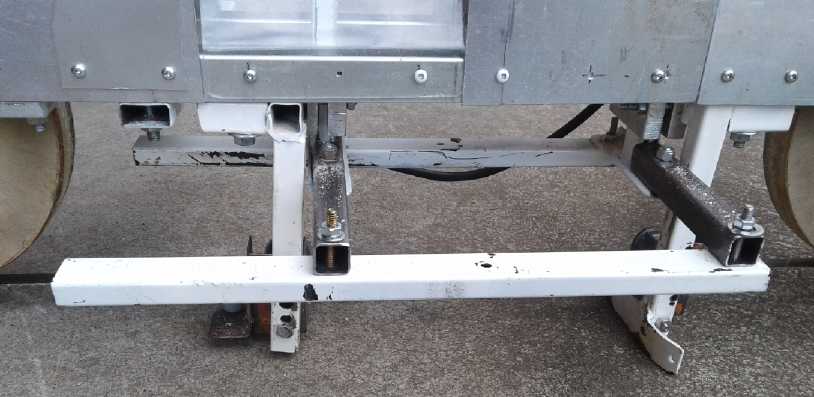 16th: I finally couldn't stand having to have
the "skis" set to exactly
the width of the guide board. That wasn't so bad cutting from squared
cants, but it was a real nuisance with a log of varying width. I'd had
to screw pieces of 2"x2" onto the edge of the guide board and adjust
the "skis" outward to match, and even so, slice bits off the edges of
the log with the chainsaw. I cludged together a way to mount the same
"skis" crossways from the same "legs" and "feet" sticking out from the
bottom of the saw. I figured the rear one didn't have to be very far
back since the saw was cutting forward, but I stuck in some extensions
to the feet at the front. The bars going across (the former skis) had
specific holes, to which I added a couple. Some way to be able to slide
them for
setting the cut width would be much better, but this was what could be
worked in easily.
16th: I finally couldn't stand having to have
the "skis" set to exactly
the width of the guide board. That wasn't so bad cutting from squared
cants, but it was a real nuisance with a log of varying width. I'd had
to screw pieces of 2"x2" onto the edge of the guide board and adjust
the "skis" outward to match, and even so, slice bits off the edges of
the log with the chainsaw. I cludged together a way to mount the same
"skis" crossways from the same "legs" and "feet" sticking out from the
bottom of the saw. I figured the rear one didn't have to be very far
back since the saw was cutting forward, but I stuck in some extensions
to the feet at the front. The bars going across (the former skis) had
specific holes, to which I added a couple. Some way to be able to slide
them for
setting the cut width would be much better, but this was what could be
worked in easily.
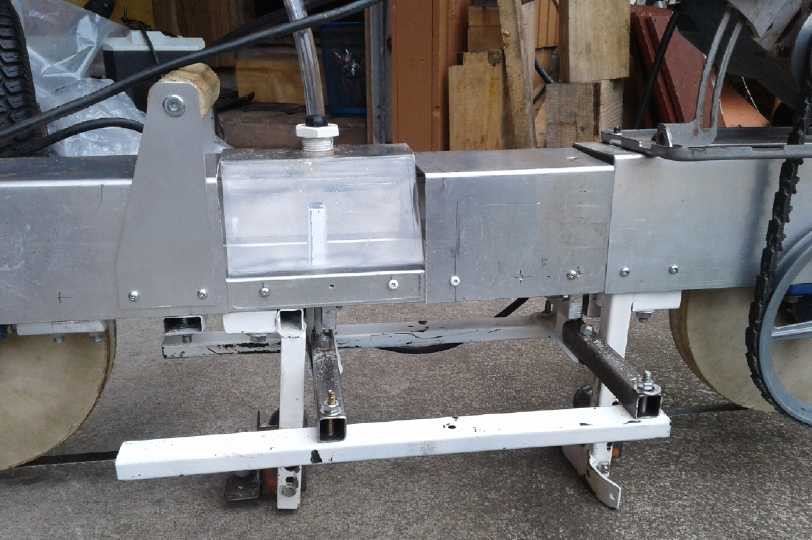 And I cut the right side guard
and swapped the short section
of it for the transparent section in order to be able to look down on
and monitor the 'in' side band guide and the blade protector. To my
surprise, I hadn't really moved it over as far as I expected. There was
only a couple of inches window out as far as the guide. What it was was
that the guide can be moved, and it was out at 9" instead of 6". It
should have a much longer transparent section to see it wherever it's
set. But then I found that a bit of sawdust built up on the plastic on
the inside. To see much after a short time it really needed a
windshield wiper, so it wasn't as useful as I'd expected.
And I cut the right side guard
and swapped the short section
of it for the transparent section in order to be able to look down on
and monitor the 'in' side band guide and the blade protector. To my
surprise, I hadn't really moved it over as far as I expected. There was
only a couple of inches window out as far as the guide. What it was was
that the guide can be moved, and it was out at 9" instead of 6". It
should have a much longer transparent section to see it wherever it's
set. But then I found that a bit of sawdust built up on the plastic on
the inside. To see much after a short time it really needed a
windshield wiper, so it wasn't as useful as I'd expected.
I also ordered some new bands. I found they now have some
.025" bands, a little thicker than the .022" but still thinner than the
'regular' .032". I also saw that they had a 1" blade with only 3/4 of a
tooth per inch (3 teeth per 4") that was supposed to be for band mills.
But it was 1" wide, which would now be hard to fit on my saw and .032"
thick, which I figure would probably be hard to flex around little 10"
wheels.
I cut another board and it
went better than the previous
one, but it was the most warped, uneven board yet. Also the widest.
Again one board on the 17th. It seemed to cut better and took less
time, and some of the warping seemed to be from the guide board not
being straight to start with. I started getting better at pivoting the
saw left and right so it would cut first on the left, then across the
middle, and then concentrate on the right. (Not an option for a rail
mounted bandsaw mill!) The left (blade exit) edge was actually pretty
straight, but the right (blade entry) side still waved up and down. I
think when I pushed the right side forward, it seemed to bite in
farther and faster than I meant to go, and this would doubtless
contribute to veering off the line. I found a better guide board. I'd
have cut another slab except the power went off. It was only an hour,
but by then I'd put the tools away.
On the 18th the next cut went pretty smoothly and only
took a few minutes. At that point I was at the bottom of the log and
cut the rest into firewood. The crossways depth glides were a big
improvement. Much of the board was fairly smooth with a big bulge in
just one area. And much of the cut was still 8-9" across. It seemed I
was getting better at it! I spent the rest of the session cutting
branches into firewood.
All very well, but what about the spruce? A week of good
summer weather had gone by and all I had done was create another pile
of branches and crap to be dealt with, and added two more 1' across by
10' long logs alder logs to the logjam. Oh, and improved the saw a
little.
I decided to venture to cut a 12' long 6"x6" spruce beam
into two 3"x6" beams for the outside header beam of my lumber shed. It
took 10 minutes and was just as wavy as any. Cutting seemed to go well.
Half the time was stopped waiting for the band to cool and get tenser
again. I still had it set to 9" wide and so the band had 4" between the
guide wheel and the wood to twist in, so the wavy result isn't
surprising. That was because I thought I would have to drill new holes
to set it to 6", but I noticed later there was a hole in about the
right place in each skid. (but if they're 1/4" too narrow it wouldn't
have worked). As it was in the last 3' I repeatedly twisted the saw
back and forth as far as it would go before the right guide wheel would
hit the wood, and that end seemed to come out with just one notable
wave. Again most of the waviness was on the right side, while the blade
exit left side was pretty straight. The saw is heavier on the left
(motor). I should be able to move both sets of band guides over a bit
farther to get some of the weight on the right side so it won't tend to
lift during cutting. (That just might be a fair part of the problem.)
Poorly as the cutting had been going, I had cut wavy
spruce
lumber for headers and 12 foot 2"x6" rafters for my lumber shed, and at
the same time had made a good dent in the pile of wood that was in the
way, right where I wanted to build it. And I had some 1" alder for
furniture or something if I planed them down thin enough to to take off
all the
deep irregularities. I'm sure with spring band tensioners, sharp,
somewhat thicker bands - and practice - the cuts will get better. Can
they be as flat as everyone including me will want? That remained to be
seen.
---
Finally: Good Results!
29th: After a week of doing other things than bandmill and cutting, my
new bands had come. In the afternoon I put one on. Changing bands is a
bit of a nuisance operation that should be improved for production if
possible.
I also replaced the spring in the band guide plastic piece
with a stronger one. I had noticed that the band was pushing the slit
open, allowing the band to be at an angle different from the one the
guide wheel was at. Again it was making a triangular gap, just like
before with the
offset wheels. My fix hadn't fixed it! Here was the main reason for the
band dipping down below the cut line: it wasn't at first aiming up
again when it went below. I think this was the most crucial change, to
keep the band well aimed to the guide wheel's angle. The stronger
spring finally solved the problem.
Also the new bands definitely felt thicker and stiffer.
There was
obviously less possibility for them to flex much inside the wood
between the 'in' and 'out' guides.
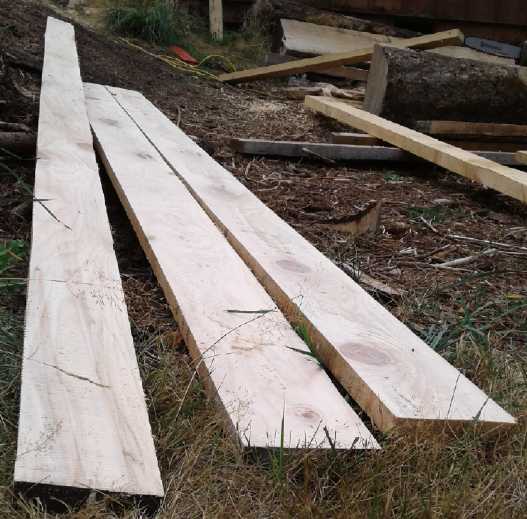 I took it out
and cut a 5.5" wide board, 14 feet long and
1.25" thick. The super sharp new band definitely cut faster. It blazed
through 10 feet in pretty exactly one minute (of actual cutting time -
I stopped briefly three times, to look and put in a wedge, and to
reposition myself as it cut). I then cut two more 6-1/8" wide and 10
feet long. Even at just 5/8" wider they seemed to cut noticeably
slower, but still quite well and I timed the first one at about 90
seconds for the entire length, still over 6 feet per minute.
I took it out
and cut a 5.5" wide board, 14 feet long and
1.25" thick. The super sharp new band definitely cut faster. It blazed
through 10 feet in pretty exactly one minute (of actual cutting time -
I stopped briefly three times, to look and put in a wedge, and to
reposition myself as it cut). I then cut two more 6-1/8" wide and 10
feet long. Even at just 5/8" wider they seemed to cut noticeably
slower, but still quite well and I timed the first one at about 90
seconds for the entire length, still over 6 feet per minute.
Between the new thicker band and the stronger spring, all
the problems seemed to be solved. They were beautiful boards, perfectly
straight and even along their whole length. No dips and bumps, no bows
across the width. The band stayed cool and so the tension didn't loosen
off much during cutting.
I started thinking I could use my boards as wall studs and
siding to enclose the roof over the travel trailer. If I got as far as
turning it into a dwelling, I could hopefully sell the trailer and get
my money back from it instead of selling the lumber.
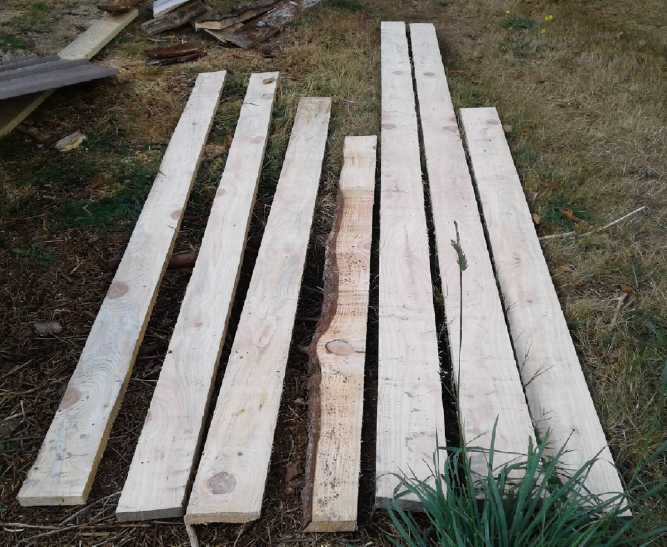 30th: It looked like it
would rain. I cut seven more ~6" wide boards
totaling 72' length in the morning in about an hour and a half. Part of
that time was spent cutting the several scraps that became too thin to
make more boards into firewood and carting them to the firewood shed.
However, each board seemed to take incrementally longer to cut until
the last one was below 5 feet/minute. At the same time it became
incrementally harder to push the saw. The harder I pushed, the more
likely the rear skid, or one side or the other, was to lift away from
the guide board. This of course cut curves in the otherwise seemingly
pretty straight cuts and made still more friction. Now that I was
cutting enough wood at a time to start feeling the difference I
recognized that gradually dulling bands had been another part of my
problems. Or at least I thought so... but it turned out there was a
reason they dulled so fast.
30th: It looked like it
would rain. I cut seven more ~6" wide boards
totaling 72' length in the morning in about an hour and a half. Part of
that time was spent cutting the several scraps that became too thin to
make more boards into firewood and carting them to the firewood shed.
However, each board seemed to take incrementally longer to cut until
the last one was below 5 feet/minute. At the same time it became
incrementally harder to push the saw. The harder I pushed, the more
likely the rear skid, or one side or the other, was to lift away from
the guide board. This of course cut curves in the otherwise seemingly
pretty straight cuts and made still more friction. Now that I was
cutting enough wood at a time to start feeling the difference I
recognized that gradually dulling bands had been another part of my
problems. Or at least I thought so... but it turned out there was a
reason they dulled so fast.
Adding what I cut on the 29th the total length of the cuts
was about 106 feet. With a chainsaw mill one would have stopped and
sharpened the chain every few boards - every 50' maybe for 6" cuts? Why
should one expect not to have to sharpen a light band fairly often,
too? The difference was that there were a lot more teeth on the band (3
per inch, 95 inches), and no really suitable file made for doing it. I
would have to continue to use the 'dremmel' 1/8" diamond cylinder on
the cordless drill. (Actually, that's easier. It just doesn't seem like
because there are so many teeth.) Later someone said
that in mills where lumber was being cut all day, even the heavy bands
used on the headsaw are changed at least 4 times a day, often more:
before or after work, at lunch, and in both coffee breaks. They don't
show you that part in the videos!
For a production model and sales, one could probably get
them to make the same bands with 2 teeth per inch - 1/3 fewer to
sharpen.
On September 1st I
sharpened the band and cut another 13
foot 6" wide board, then two more. The band seemed sharp to start with
but it was starting to get
dull again by the time I was through one board, and the third one was
pretty tough going. I
was sure the slow cordless drill couldn't have overheated the teeth.
Why didn't it stay sharp as long as when I had first bought it?
Overheated Bands
Well sometime by early the next morning, I finally figured
it out. I wasn't overheating the teeth during the sharpening. I had
already been overheating the band during cutting. That's why it got
dull so soon, and why once it was dull I could sharpen it, but it
wouldn't last. Where was my head? When I started out, overheating the
band was one of my big concerns and it's why there was now (at last) a
water drip
device. It seemed when things got tough there wasn't enough cooling -
seemingly nothing like enough - and the band got pretty hot and became
slack. At the same time the teeth lost their hardening so they dulled
and would no longer stay sharp for very long.
I changed the band again. I now had four bands that had
doubtless all lost their tempering, one on the saw and one more spare.
Then I pulled out the sponge at the bottom of the water tube. I cut
part of it away, making it thinner so that it was less squeezed and
water
would flow through it more freely.
I cut a rough edge off a small remnant cant, reducing it
from 6" wide to 3.5". Then I cut two 3.5" wide boards from it. It was
about 8' long. The saw zipped through each board in about 30-32 seconds
of 'power on' actual milling time. Now that was milling! (It actually
takes longer total time because I stop the saw frequently to move
forward, to reposition myself to keep up with the saw. and for now to
check band temperature with my fingers.) The dimensions
were good and pretty straight, but I must remark the surfaces looked
rather
rough, especially compared to most of the other boards, because each
tooth had cut so much at once as it raced through. Like they'd been cut
by some coarse sawmill. With the fine 3 teeth per inch bands the wider,
more slowly cut boards mostly looked really nice. They hardly needed
planing
to see the lovely grain of the spruce.
It didn't get more than slightly warm in the narrow cuts
and with a little more water flowing. The
water flow rate still seemed awfully slow, and I made sure the tube was
filled above 1/2 way
whenever I was cutting, below which it took a long time to finish
draining. It would be nice to have a small plastic jar on top so that
it had a consistent 'head' of water until that ran out. I congratulated
myself on the arrangement with the tube screwing into the top of the
saw. The whole watering mechanism could be removed to clean or adjust
it, or replace it, just by unscrewing
it and screwing in the cleaned or a different one until it was thought
satisfactory.
For example, one might have an "eyedropper" type end or a fine spray
instead of a
sponge, or add a shutoff valve. Or put on that top reservoir.
When I went for the next cant I decided to try cutting a
couple of 10" wide boards - it seemed like a good size piece to do
that. I used the Poulan chainsaw in the mini-mill to square it to that
width. (Ugh - gas, noise!) Now I was getting good cuts there was
nothing like pushing the limits to see what it was really capable of.
after all, it was supposed to be a sawmill! This was where the
makeshift arrangement I had made for the skids came back to haunt me.
They needed two more holes to set the mill for that width. But perhaps
holes every couple of inches was as good as a sliding part? After all,
the setting didn't have to be exact. Anywhere wider than 6" could cut
6". I had cut the 3.5" widths at the 6" setting (and still using the
5.5" wide guide board) and they came out okay. The "8 inch" setting I
had used with the alder actually did up to 9.5".
But I had to go. I didn't get back to it, and besides it
was September and high time to get this already lengthy newsletter out!
If I'm often doing less actual project work, I certainly seem to find a
lot to say each month these days, and this is probably be the longest
one yet.
Nevertheless later I cut the holes in the skids (for up to
13" wide) and on the 3rd and 4th of September milled up most of the
rest of the alder log, around a
foot in diameter, making many 1" boards, 8 to 10" wide, and even up to
11". And some bevel siding. Everything went smoothly and the band
hardly got warm. Now that was really milling, with quite wide cutting,
after all!
And I note that if I had been using a chainsaw mill, I'd
have got only around 2/3 as many boards from the same logs, as the rest
would have been made into sawdust. I got a 50% bonus in boards; more
value from each tree.
Heavy Saw
I wondered how the 40 pound saw might be lightened. I
could use it. I could lug it around. But lifting it up higher onto the
workbench was a struggle. When I
first took the
band off to replace it, I took a fat plywood wheel assembly off - the
one without the V-belt pulley - and weighed it. It was 2961 grams - 6.5
pounds. So both wheels with their axles and bearings (13 pounds) made
up 1/3 of the entire weight of the mill.
There was certainly a place some savings might be had. One of the
pillow block bearings was 625 grams. Trimming, eg, 5 pounds off the
wheels would by itself bring the saw down to 35 pounds. 1/2" or 5/8"
shafts instead of 3/4", and the smaller bearings and holders for those
smaller shafts, would certainly cut down the weight. Some lightweight
alloy wheels would be better all around too, as well as lighter.
The large top cover was 862 grams. the other one with the
motor on it was shorter so it would have been 12"/19.5"*862=530 grams.
I
probably wouldn't want to lighten up the piece holding the motor, but
the
862 side could probably be lightened up with thinner metal or plastic.
But then probably one wouldn't want it too much
lighter. It "bucks" just a bit when the motor is started, and this
might be almost destabilizing if it was really lightweight.
Since one person needs both hands holding it to operate
the saw, and stands behind the blade, and with the covers over the top,
it seems pretty safe. Nonetheless, a couple of extra light pieces
covering the end and wheels would be nice, and another piece or two to
cover the unused section of band for narrower cuts (ie, most of them)
would
be nice.
These will be considerations for a production prototype
mill.
Production?
With the self correcting band guides making for reliable
straight cuts and now a whole alder log cut into boards, the Carmichael
Mill has demonstrated itself to be a clearly
superior machine. It takes less power and uses thinner bands taking
less kerf than any other mill. It's probably about ready
for a production prototype wherein the finer details are worked out
more optimally (there's still a considerable "deficiencies" list), and
then production.
With a 2" thick guide board on top
of the cut, the cutting depth is reduced to just a bit over 2". 4.5"
sounded like plenty for the prototype. I hadn't thought about the guide
board reducing the available depth. With 10" wheels, the maximum
possible cut depth is under
10", if nothing else was in the way below the top of the band. The more
the center of the wheels sticks down below the "backbone", the more of
that 10" is available. The "pillow block bearings" offset gave about
1.5". Some custom parts could improve that, as well as improving other
aspects of the design.
The other main undecided point would be what motor to use.
At first I was sure that Ryobi skillsaws weren't a production
unit option, but it seems to work pretty well. They are cheaper than
any suitable motor I know of by itself,
widely available and simple to
mount. 120 volt, 12 amp, PM lawnmower motors might also be a good
option. I
can't help but think a 24 or 36 volt BLDC motor like the Electric Caik
might be appropriate, and amenable to battery operation, which just
might make them useful in the woods. But that would certainly cost far
more
for the motor, plus the solid state motor controller on top of it.
With the Ryobi skillsaw, standing behind the motor seemed
to put the trigger on the wrong side, and one pressed it with one's
little finger or had the left hand in an awkward position. (Chainsaw
mills the have triggers in awkward positions, too. With the Poulan saw
in the "mini-mill", it's backward and I keep hitting its "off" switch
with the heel of my hand and stopping the saw.) But then I
tried standing on the right side of the wood instead of the left. The
left hand then was held the other way around in the right position to
press the trigger with the index finger. And the right hand was right
behind the handle for holding the mill straight. That way was better
and seemed to make the skillsaw as close to a perfect part as one
needed. And as long as Ryobi keeps making a similar model, they're
cheap and easily replaced by the customer in case one should burn out
or otherwise fail.
Solar Panel
Installation: Solar and Wind (Hydro) Grid Tie Inverters
I decided I wasn't going to get around to any sort of
"off-grid" type installation this summer, but other than the grid tie
inverter that only delivered half the stated power, a little over 400
watts from a unit that had "1000 Watts" printed right on it, the grid
feeding system seemed to be working quite well, and the power gets put
to use. And when the output just plugs into a wall socket instead of
having
to be wired into a breaker box, it's simple to do. Since I already had
the four panels up (~1000 watts), I thought I would get a real 1000
watt grid tie inverter to double the power output. Then, I just might
get around to putting up the other two panels and hook them to the
present inverter.
I started looking at grid tie inverters on line. The model
I already had was the cheapest "1000 watt" inverter. That stood to
reason since it wasn't really 1000 watts. There wasn't much
enlightenment in the reviews. Most people seemed to have just hooked it
up and said "Ya, works great!" One guy said it worked great and he was
getting 420 watts on a cloudy day. But I bet it didn't do any better on
a sunny day, either! I bet almost none of them had meters to check the
output level with!
OTOH, it was working quite well and seemed quite reliable.
It seemed to limit its output to what it could handle instead of
overheating. It hadn't blown up when the DC input sparked or at any
other time. I decided that while it was obviously being misrepresented,
it was a good product for a good price, now only about 75 $US from a
couple of sources. (Plus 60 $ shipping for two. I discovered under my
account at Aliexpress that I had paid 150 $US, so they've come down in
the last couple of years.) Rather than order a different type/brand of
[presumably actually 1000 watt] inverter, I would order two more the
same for probably no more money. And then even if one did fail, I'd
still have two working. A number of stores at Aliexpress.com had them.
Some asked higher prices. (There was another one, that was in the same
aluminum extrusion case with the same everything - just an anodized
cadmium color and a different label. Hmpf! There were also other
obviously different models.)
I decided also that I should put the utility stuff in the
garage instead of the inside closet, which I hadn't started wiring up
except for the one cable from the panels. And that could still be of
use for a heavy 38 volt DC outlet or sub-panel. The garage was the
closest run from the panels, and for the batteries to be placed
outside. And the whining cooling fans of the inverters, coming on and
off, wouldn't be heard from in the house. I would separate the panels
into two pairs of 500 watts - 3 pairs if I put the other two panels up.
I must remark again that solar power just keeps getting
cheaper and better. A system of a 300 watt panel for around a dollar a
watt(?) and a grid tie inverter for 100 $ can be thrown together
quickly if you can do it yourself and will start you saving on
your
power bill for perhaps under 500 $ - which may be a single power bill
payment or two. If you live in a reasonably sunny place that gets 2000
hours of sunlight per year, and electricity is 15 ¢/KWH, that
would theoretically save around 90 $/year and (if I have it right) pay
itself off in 6 years. for each panel-inverter pair. (if rates rise,
even sooner.) If your area uses fossil fuel to make electricity, you're
helping cut pollution and saving the environment.
Alternatively two 250 watt panels (a bit lighter each to
get onto a roof) and the inverter would be probably over 600 $ and
would save 150 $/year.
A Floating
Tidal Power Vessel?
(Well... I wrote this over the month,
but
with the example of the fabulous tidal power machine in the next
article, by September 3rd I finally decided to either get sufficient
community support (read: somebody finds the money) to do something like
it, or drop it altogether. As a utility scale project, this would
really cut diesel power usage. Forget doing any
small "home scale" unit.)
Along with the solar units, I considered also getting a
grid-tie inverter made for wind power. These came in 1000 and 2000 watt
sizes. They cost more, but tie directly
to 3 phase PM alternator outputs like my "improved Piggot" design, and
have "dump loads" to keep the
windplant loaded (so it won't over-rev) while not overloading the
inverter in higher winds. They seemed to be around 300-500 $US. I have
only a little interest in doing wind power per se [trying out a VAWT at
home might be cool], but it would also be an ideal grid tie for a small
floating hydro generator.
If I can induce a very few people to help make one to put
on the Tlell river, there's the ready-made means to connect it to the
power lines. I decided to leave it to see if others would contribute to
the project first. I don't want to do it all myself.
But I wanted to do some preliminary work and study first.
If it was a "go" and each stator in the generator outputs 2000 watts
when
the water is flowing well, each one could be hooked to a 2000 watt
inverter. Obviously the bigger the catamaran and the bigger the
"paddlewheel", the more stator-inverter pairs that would be useful.
(I'm dropping the "turbines in pipes" idea... for
now... probably. So, how about the "venetian blind" curved vanes
'paddlewheel' design
in TE News #106?)
On the 28th I went to the river at 1:20 "PM" (really still
before noon). Someone said low tide had been at 10 AM, so it was about
mid-tide. At the highway bridge, there was no sign of the tide yet. The
shallow river was still flowing out probably less than 1 meter per
second. Perhaps it would be better further downstream? I drove as far
as I could, two kilometers down to the end of Beitush road.
There were signs of some inflow, but it wasn't very much or fast yet.
That
was the end of the line. There were no power lines any farther
downstream.
But there was a trail from there and I started walking
downstream. The farther I went - and the higher the tide was rising -
the more and faster the inflow of water. By the time I'd walked maybe
1-1.5 Km the water was rushing in. I eventually got down to the mouth.
(If I had known I was going for a 5 Km hike on loose sand and
coarse gravel I'd have worn hiking
boots. It was definitely hard on my feet. They seem to have weakened
since I was hiking a lot in cheap runners 20 years ago!)
I was repeatedly estimating how far foam and things on the
water moved
over 3 second intervals. 10 feet would be 1 meter per second, and 20
would be 2. Over much of the course the water seemed to be
inflowing at around 2 meters per second. There were fish jumping. I saw
a seal and a big salmon with a red head. By the time I got back to the
bridge at about 3 PM the tide was coming in there too, still at almost
2 m/s. If low tide was at 10
AM, high tide would be about 4:15 PM. Apparently one could only expect
tidal power during the upper half of the tide where the power
lines started, at the bottom of Beitush road. Whether it flowed as fast
on the ebbing tide as it did when flooding should still be checked out.
But it seemed it would produce "full power" over at least about 5-6
hours per day, and it would also produce a certain lesser amount during
lower tides just from the flow of the river, which might be substantial
if there were heavy rains.
Those power lines ended at the "Haida House at Tlaal" at
the foot of the road. To connect to them, we would doubtless need their
approval. On the way home I picked up a hitch hiker. It turned out that
she worked there, had been active in native politics, and was sure they
would be enthusiastic about the idea. (And she was sure the "Council of
the Haida Nation" would be very interested in a larger project in
Masset inlet - see next article below.)
Having a figure for the speed gave me a way to very
roughly estimate how much power might
be expected. At least, how much might be expected during a typical
rising tide.
From wind power:
Watts = K * Efficiency * .5 * mass * Area * V^3
"K" for metric is 1. Somebody did a fantastic job of defining all the
units so that this would be so.
Efficiency or coefficient of performance is how much of the potential
power flowing by is actually extracted.
The last parts are derived from the well known general formula E = .5 *
mass * V^2, in kilograms and meters per second giving "E" in
watts. But the mass is the mass of the air or water going by, which
depends on the area of capture and the wind or water speed. If the
speed is doubled, twice as much air or water mass flows by in a second,
so instead of V^2 it's V^3.
(note: Kilometers per hour = meters per second * 3.6. Miles per
hour ~= m/sec * 2.25)
Say the paddle wheel captured 2 square meters of water
frontage, and managed 30% coefficient of performance. (Theoretical
maximum for a single windplant propeller is 59%. For a paddle wheel I
don't know but let's not expect too much.) Water is heavier than air, 1
megagram per cubic meter instead of 1.4 Kg.
Watts = .3 * .5 * 1000 Kg/m^3 * 2 sq.m * (2 m/sec^3)
...
=
2400 watts.
The V cubed factor is really startling. In water moving
just one meter per second, there'd be just 300 watts. If it got up to 3
meters per second, it would be 8100 watts. Unlike wind, the tidal flow
probably won't get way higher than its average at any time. However in
heavy rains, the regular river flow might reach higher figures. However
again, those figures might have more power in them than the generators
and inverters can use, but the paddle wheel even if unloaded won't
reach dangerous speeds like a windplant propeller can in high winds.
And some places as one looked across the river the water
was definitely flowing faster than others. Generally near the shores
was much slower. An aspect to the great effect of velocity on the power
is that I got the idea to put a rudder and two pressure sensors on the
vessel. The idea is that it would, within limits of being moored,
automatically and continually steer itself across into the fastest
flowing part of the stream as the flow changes and then reverses. If
that's say 10% faster than some other position, that's 33% more power.
I should think that would be well worth while.
On the 31st I went there again on a falling tide, almost
out, and found only a couple of shallow "rapids" with much flow. I
started to get a bit more feel for the river and its pools and flows.
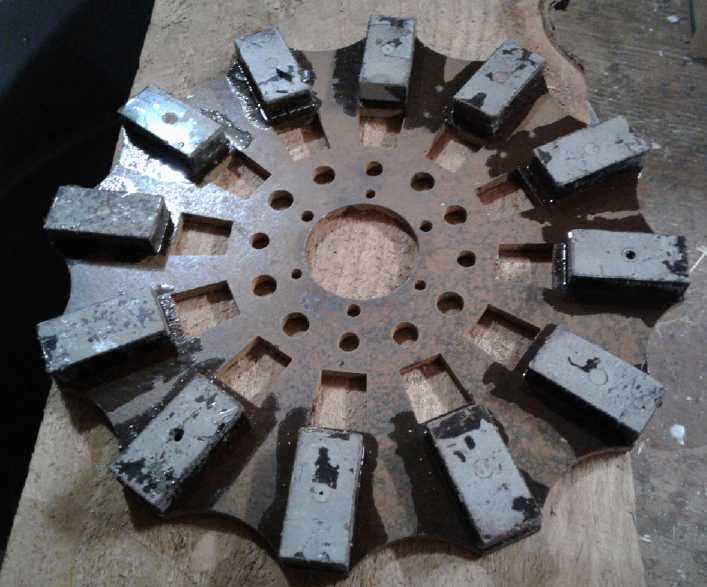 I
started to think it might be a good idea to at least
finish the improved Piggott alternator I had started in the months just
before I moved - early 2017. I found I didn't have any more sets of
unused 1" x 2" x .5' magnets. (Lots of 1" x 2" x 3/8" ones for Electric
Hubcap motors.) But I had a previously set of 12, some more used ones
and 4 new ones all of
the same type that made 23 (#24 was corroded), and I used a different
brand for #24. On the 30th I cleaned the epoxy off the set of 12 and
wire brushed the rust off one of the custom CNC waterjet
cut rotors. On the 31st I found and cleaned the other 12 and brushed
off
another rotor, then I mixed a bit of epoxy, painted it onto a rotor,
and set the first 12 magnets in place.
I
started to think it might be a good idea to at least
finish the improved Piggott alternator I had started in the months just
before I moved - early 2017. I found I didn't have any more sets of
unused 1" x 2" x .5' magnets. (Lots of 1" x 2" x 3/8" ones for Electric
Hubcap motors.) But I had a previously set of 12, some more used ones
and 4 new ones all of
the same type that made 23 (#24 was corroded), and I used a different
brand for #24. On the 30th I cleaned the epoxy off the set of 12 and
wire brushed the rust off one of the custom CNC waterjet
cut rotors. On the 31st I found and cleaned the other 12 and brushed
off
another rotor, then I mixed a bit of epoxy, painted it onto a rotor,
and set the first 12 magnets in place.
In that something odd happened. The used magnets (even
with the bumps sanded
off) had an epoxy pattern visible on one side. I wanted that side to be
down. There would be 6 with their "north" face up and 6 "south". As far
as I knew I had set the magnets, spaced well apart from each other, in
random places, and I took no care which order I grabbed them in. To be
the right way up, each magnet had to repel the one
I had just set in place. I put one in place. The second one was the
right polarity with the pattern down. So was the third one. And the
fourth. The first one could be either way up, and the last one would
inevitably be right since they had previously been mounted 6 and 6.
That left the 10 in the middle as quasi "random", each with seemingly
almost a
50-50 chance. Yet every single one was the correct way upon the first
try. It was like flipping a coin and getting the same result 10 times
in a row. The odds against that are 2^10 or 1 in 1024! (For
someone who tries to to plug 120 volt plugs in backward 9 times out of
10 also against apparently 50-50 odds, that somehow seemed remarkable
enough to write down.) The phenomenon wasn't repeated on the second
rotor where several magnets needed to be reversed.
---
But when I read about a very successful tidal power
project
(next article below) my ideas started to change. Perhaps the
paddlewheel was doing it the hard way? At the least in the unit's hulls
I thought I'd like to include mountings for two potential outboard
propellers that could be added later. I'd have to keep them small for
when it's shallow, but they might be a demo and test platform and add
some extra power to the unit.
But then the idea of enclosing the propellers in pipes
again can come into play. "shallow" would be fine for enclosed props.
The pipes would have broad "scoop" intakes to get a venturi effect, a
faster flow going by right at the propellers. Those inlets would be
flat on the bottom to accommodate the shallow water at lower tides, and
would have a grill on the front to keep fish and debris out.
In fact, maybe a single hull with an enclosed prop turbine
on each side would be optimum? A single hull instead of two is an
obvious saving in effort and materials. Would the two ram scoops each
leading into a round pipe be harder to make than one big paddlewheel?
Here the duplication would be having two of each mechanical thing: two
props, two sets of bearings and mechanical linkages, two generators and
two inverters.
Or might it be better to have a single propeller directly
underneath the hull? If it was a broad scoop with a flat bottom, then
it could rest level on the bottom in low water and float when it was
deep enough. Only one set of mechanical parts would be needed, albeit a
larger set to capture the same amount of energy. Perhaps the top of the
scoop could be the bottom of the hull.
Aw, to heck with it! Better to emulate the project below
and put some real power into the grid!
Scot Power
Floating Tidal Power Vessel
Here is an amazing project,
brilliant in its simplicity. At first I thought to just write about it.
Now I'm hoping we can do one in Masset Sound, the high flow
water channel to Masset Inlet.
It's a 210 foot
single hull vessel that has been successfully deployed in the Orkney
islands and which has generated 3 GWH of electricity in its first full
year of operation. At
10 ¢/KWH, that's 300,000 $ worth of electricity. It's also more
power than all previous tidal flow and wave power systems
combined, counted over the last 12 years. Instead
of a paddle wheel, it uses two propellers, one on each side under the
water... just about like underwater windplants. (They may
counter-rotate to cancel forces that would try to tilt the vessel?)
They
are located near the stern so the anchored vessel always faces into the
current. Unlike the various small shallow water units being thought of
around
here, this one must operate in water deep enough that the large
propellers will never hit bottom. The hull is simply sections of large
steel
pipe welded together.
 Could it get much more simple and "to the
point"? And this is just "Version 1.0".
Could it get much more simple and "to the
point"? And this is just "Version 1.0".
(A newer design on their website allows the turbine units to be floated
into place,
then
attached, then pivoted down under the water with hydraulic(?) levers on
deck.
That is much more maintenance friendly, so we see the bugs are being
worked out
of a very exciting new concept.)
 Presumably that's anchored. It looks like quite
a current flowing past.
Presumably that's anchored. It looks like quite
a current flowing past.
But how fast does it flow? The cube of the speed means
everything.
A flow of 3 meters per second (10.8 KmPH) has 27 times as much
power
per area as 1 meter per second (3.6 KmPH) has.
Of all the various windplant types, the simple 3 rotor
propeller is the one that eventually everyone settled on for major
power projects. I get a sense that this design is the way to go for
community power projects where strong tidal currents are available. How
fast are those currents, anyway? On September 3rd I searched on line
and found a study of Masset inlet for this very purpose from 2004 that
suggested 34 MW could be obtained with only 10% reduction of the usual
flows, and that the maximum speed of the currents was around 2.5 meters
per second. (A maximum of 10 MW "for the island" is needed - so maybe 3
or 4 MW for the north grid.) That would be well over 2 kilowatts per
square meter of
propeller, derated by inefficiencies to one. If the vessel was over 200
feet long, it looked like a propeller was about 50 feet or 15 meters
diameter. 15^2 * pi/4 = 177 square meters or 177 kilowatts,
times 2 propellers makes 354 kilowatts. (Wow, for the rated 2 megawatts
the tidal currents in the Orkneys must be headed for 3.5 m/sec or 12.6
KmPH. Actually to get 3 GWH in a year it might be making around 500 KW
when the tides are running, so one suspects the maximum might be
somewhere around 3 m/sec. Still fast!)
By September, I started thinking this sort of project
would be the thing
to do. Forget about smaller scale of demo projects and my own designs.
Here was something already proven to work, that could really power the
north grid of the island and seriously cut the diesel usage.
One or more of them might largely take the place of the
diesel generators. The question may be: Do we make them, or buy them
from Scotland? Most ideally, for once I would rather simply order such
a machine than build anything. Well, there were no figures on cost, and
it didn't look like they'd be exporting any any time soon. Then, what
ready
made components are available? Hundreds of kilowatts is really out of
the league of my improved Piggot alternator - unless scads of rotors
and stators were to be strung together on long shafts - so I have
little in the way of special components to offer. But I could get the
ball rolling.
Or maybe I could make much larger rotors and
have quite a few per shaft? Or have thicker stators with more copper
and up the RPM? Since I'm putting one together, I'll certainly try a
few
variations. Maybe tests will show that my quite minimal expectations
will be substantially exceeded?
Rechargeable
Battery Making
with oxalate electrolyte:
Lead-Zinc Cell From Scratch With Rolled-up Sheet Metal Electrodes
On the 17th I was visited by two members of an off-grid farming family.
They were interested on the improved Piggott alternator, but more
especially in batteries. It was a good reminder that those today are
either short lived or high cost, and people keep looking for something
better that they can afford. It's hard to know what advice to give.
They were very interested in the strips of zinc and lead and asked
questions like was that just moss-killer zinc for roofs that you buy in
rolls (yes), and what the voltage was (1.7). I said I'd try to get the
rolled-up PbZn cell done and tried out by the end of the month. And
send that to the DIY battery e-mail lists too, of course.
 I etched the
zinc strip for about 20 seconds in ferric
chloride to increase nano-scale surface roughness. I didn't do anything
to the lead. I'm not sure what might help. Previously I had rolled the
sheets thinner using a
textured roller in the rolling mill, also trying to get more surface
roughness.
I etched the
zinc strip for about 20 seconds in ferric
chloride to increase nano-scale surface roughness. I didn't do anything
to the lead. I'm not sure what might help. Previously I had rolled the
sheets thinner using a
textured roller in the rolling mill, also trying to get more surface
roughness.
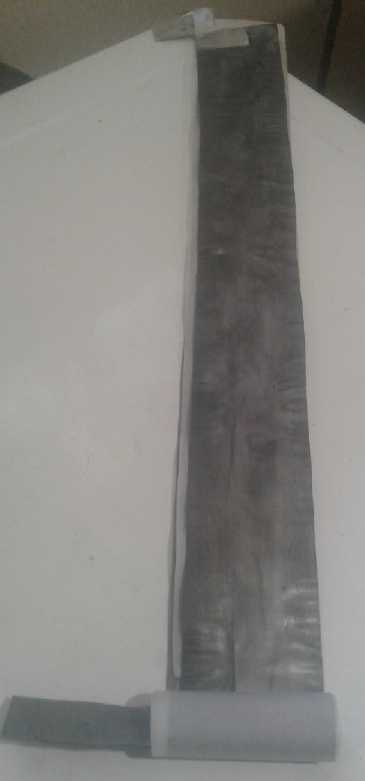 Being about out of watercolor paper, I got some parchment
paper from a kitchen drawer (from a grocery) and cut a long strip. I
folded it in a "V" over the lead. As I tried to roll it up it kept
moving over to the outside and I had to keep crinkling it to keep it in
line. The zinc was 82 grams before etching and I forgot to weigh it
after. The whole with the lead, zinc and paper weighed just a little
over 500 grams. (Ugh - If you don't write it down right away, you
forget exact figures.) It it didn't seem to fit into a '1.25"' (really
about 1.4") PVC irrigation pipe. It almost fit in a 1.5" ABS pipe, but
not quite.
Being about out of watercolor paper, I got some parchment
paper from a kitchen drawer (from a grocery) and cut a long strip. I
folded it in a "V" over the lead. As I tried to roll it up it kept
moving over to the outside and I had to keep crinkling it to keep it in
line. The zinc was 82 grams before etching and I forgot to weigh it
after. The whole with the lead, zinc and paper weighed just a little
over 500 grams. (Ugh - If you don't write it down right away, you
forget exact figures.) It it didn't seem to fit into a '1.25"' (really
about 1.4") PVC irrigation pipe. It almost fit in a 1.5" ABS pipe, but
not quite.
Not finding anything else so convenient I unrolled it and
rolled it up again tighter. Then it had a short somewhere. There
was a rough edge on the zinc that was poking through the paper, but
after fixing that it was still suspect, giving diode-like readings -
perhaps intermittent. I cut a wider strip of parchment paper and tried
again, and this time it read "open circuit". Yay! (I wonder how many
times you can roll and unroll zinc and lead before they start breaking?)
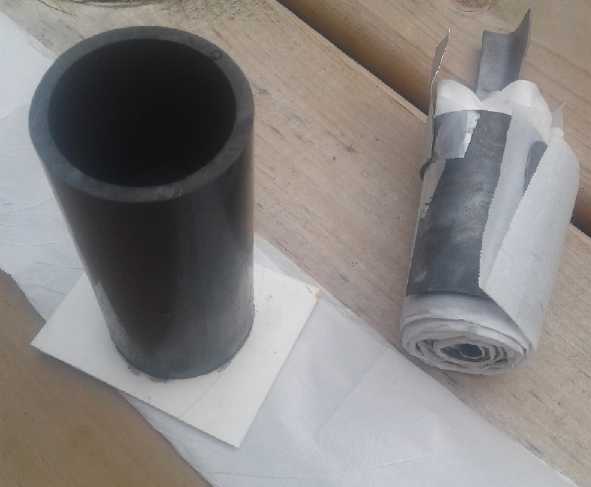 Then I cut a length of the 1.5" ABS pipe and "glued" a
flat (white) piece on one end for a bottom. I left it a while to set,
then
filled it with water. It didn't seem to leak.
Then I cut a length of the 1.5" ABS pipe and "glued" a
flat (white) piece on one end for a bottom. I left it a while to set,
then
filled it with water. It didn't seem to leak.
About 5 PM I filled
the cell and put it on charge. It started out reading 585 mV. I put 1.9
volts on it and it started drawing hundreds of milliamps, which dropped
pretty soon to 100. After an hour it was down to 70 mA. I was a bit
surprised by the low charging currents. Shorted it put out over 3 amps
for a moment. I raised the charge to 2.0 volts and it started drawing
120 mA again, then dropped lower.
Of course, it was starting out from "overdischarged"
metallic lead, which had to be converted by charging to lead dioxide or
(more likely in an alkaline environment?) lead tetrahydroxide. This
would then convert to lead [single] oxide or lead dihydroxide on
discharge.
Half reactions [at pH 12]:
Pb(OH)4 + 2 e- <==> Pb(OH)2 + 2 OH- [+.48
V]
Zn + 2 OH- <==> ZnO + H2O + 2 e- [-1.2 V]
Lead is 259 AH/Kg, so 435 g is theoretically 112 amp-hours
(dream on!)
Zinc is 820 AH/Kg, so 80 g is theoretically 65 amp-hours.
What it actually gets depends on how much of the substance
is actually available, in touch with the electrolyte. If it gets 5
amp-hours it might be a useful cell. 10 would be nicer but hard to get.
20 would be even better but unlikely. To get 50 watt-hours per
kilogram, at 1.5 volts under load, it would have to have 16.7
amp-hours. However, for a homemade off-grid home storage battery, the 5
amp-hour figure might be economical if one can get the lead cheaply,
ie, if you don't have to have it mailed to you.
I filled it pretty full with 50 mL of electrolyte,
expecting water to be used up, the oxygen or hydroxide being absorbed
into the lead and the left over hydrogen bubbling off as gas from the
already charged zinc. But instead of going down, the water level went
up and overflowed and overflowed. Apparently the lead hydroxide expands
and takes up
more room than the water.
I expected performance and capacity to increase with
charging and cycling. It would only put out a little over 4 amps
momentarily when shorted, which seemed pretty disappointing for such a
large surface area. Doing 5 ohm load tests it looked pretty weak the
first evening. It was twice as good the next morning, going from 25 mAH
to 50. But 12 hours later the charging current had gone up a bit to 80
mA, there was a froth of bubbles on the surface and it didn't perform
quite as well as it had in the morning.
 I left the
cell disconnected overnight, and the next
morning to my surprise it was shorted out. 0 volts; wouldn't charge.
The surface oxides certainly seemed to expand the metal judging by the
amount of water that overflowed as it charged. Perhaps there just
wasn't room? Well, so what? Given the low initial energy storage, I
decided that while a thin sheet of etched zinc somehow seems to work
well enough to give 5-10% of its theoretical amp-hours, a simple sheet
of lead has next to no amp-hours in it. 10 times as much energy storage
would still only be 1/2 an amp-hour. Perhaps given enough time and
cycling (and thicker separator paper) it might have got there. 100
times as much, a few amp hours, might have made it worthwhile, but
after one day, I wasn't seeing anything that promised the sort of
improvement to reach that level. Most electrode substances have to be
in the form of tiny particles to give very high surface area for the
volume. As it was, I didn't plan to spend any more time on it.
I left the
cell disconnected overnight, and the next
morning to my surprise it was shorted out. 0 volts; wouldn't charge.
The surface oxides certainly seemed to expand the metal judging by the
amount of water that overflowed as it charged. Perhaps there just
wasn't room? Well, so what? Given the low initial energy storage, I
decided that while a thin sheet of etched zinc somehow seems to work
well enough to give 5-10% of its theoretical amp-hours, a simple sheet
of lead has next to no amp-hours in it. 10 times as much energy storage
would still only be 1/2 an amp-hour. Perhaps given enough time and
cycling (and thicker separator paper) it might have got there. 100
times as much, a few amp hours, might have made it worthwhile, but
after one day, I wasn't seeing anything that promised the sort of
improvement to reach that level. Most electrode substances have to be
in the form of tiny particles to give very high surface area for the
volume. As it was, I didn't plan to spend any more time on it.
 On the evening
of the 24th I thought better of it, and
having had no time for any other experiments or project work, I
unrolled the cell. Even when it was completely unrolled it was still
shorted. The parchment paper looked good except where I had
accidentally ripped it in the unrolling. Only when I separated the
sheets and then laid one "X" across the other did the voltage start to
rise. to about .3 volts. I never did find the short. There were black
oxides stuck to all four sides of the paper. I shrugged and rolled it
up again with a new strip of parchment paper. This time I folded it
over the zinc instead of the lead (as if that should make any
difference). And I added an extra layer just in the middle. It fit back
in its "can" and I connected the power.
On the evening
of the 24th I thought better of it, and
having had no time for any other experiments or project work, I
unrolled the cell. Even when it was completely unrolled it was still
shorted. The parchment paper looked good except where I had
accidentally ripped it in the unrolling. Only when I separated the
sheets and then laid one "X" across the other did the voltage start to
rise. to about .3 volts. I never did find the short. There were black
oxides stuck to all four sides of the paper. I shrugged and rolled it
up again with a new strip of parchment paper. This time I folded it
over the zinc instead of the lead (as if that should make any
difference). And I added an extra layer just in the middle. It fit back
in its "can" and I connected the power.
It started charging limited to 2 amps and the voltage
started coming up (to 2.0 volts). I hadn't even added electrolyte yet -
the two metallic strips were just still wet and they wetted the paper.
A dry cell. I decided not to fill it up again since it had overflowed
and overflowed while charging to the point where I now just scraped up
the dried crystals off the counter with a spatula and added water to
make more electrolyte. I just added a little (10-15 cc) and the
dropping charging current shot back up to over an amp for a few moments.
After 10 minutes it was down to .19 amps. I shorted the
cell and as previously it put out over 4 amps but dropped rapidly. (At
one point I think
Adding a little more electrolyte didn't raise the charging current. I
guess the paper was now already saturated and more wouldn't help.
That night the cell shorted
out again. What could be
happening? In my head I went over the theory again: To form dendrites,
a substance has to dissolve, and then return to a solid state, either
on
charging or on discharging. Zinc doesn't have the soluble ion at pH 12
that it has at pH 14. Zinc oxalate salt isn't soluble, and neither is
zinc hydroxide at pH 12. I couldn't come up with any flaw in the
theory. Unless the charts were wrong or concealed some well hidden
strange property, zinc should be pretty
much the perfect negative electrode at pH 12.
Another idea came to me. When I had filled it, the water
had continually overflowed as the cell charged. The seemed to indicate
that as the lead charged to lead oxide or hydroxide, it swelled up and
displaced more water than it consumed. In the rather tightly rolled up
cell, it really had nowhere to go except to press harder and harder on
the thin separator paper until it pushed through it and shorted the
cell. The separator paper had bits of greyish powder stuck on both
sides in various spots and I couldn't really tell much from looking at
it, but that's my tentative conclusion.
I've decided not to use paper or fabric separators any
more. Flooded cells with pocket electrodes have long been known to
outlast dry cells. Even zinc electrodes gradually dissolving and making
dendrites at pH 14 are know to last perhaps a hundred charges in
flooded pocket cells instead of usually just a few in dry cells. The
electrodes being separated by a millimeter or two of plastic frames or
grilles just makes them much more robust. The bit of extra liquid to
fill it doesn't weigh much compared to the solid parts - and it is
refillable.
What would I do with the lead-zinc cell? I could roll the
sheets up around toothpick spacers or something. Or I could change it
to a "prismatic" stacked plates construction.
I decided the next thing to do would be to get back to the
big square cell with manganese dioxide pocket electrodes for the "+"es.
I had made just one of each electrode but had planned to put in 3 zinc
and 2 manganese. And I considered that there weren't nearly enough
holes in the first MnO2 pocket, so the next one was going to be much
denser.
At the same time I thought I'd try painting the osmium
doped film on the inside of the next pocket and see if that helped
increase available current.
But there were many competing attractions and I didn't get
anything more done.
---
As a side note, I'm wondering if the electrolyte, for all
its good properties, could be mixed to give faster reactions and
currents. (or was it just the low surface area of a solid sheet of lead
that kept it under ~5 amps short circuit current?) Potassium seems to
be about the only oxalate that's very soluble, but maybe I should try
some extras like a bit of sodium oxalate in the mix? That might up
current capacity some. (Hmm, when might I be ordering any lab chemicals
again?)
http://www.TurquoiseEnergy.com
Haida Gwaii, BC Canada

 This was
certainly the project of the month. I finally put
in a simple tube with a sponge to wet and cool the band as it went by.
As I surmised by the time I wrote the last newsletter, the self
adjusting band guides system is far superior to any previous bandsaw or
bandmill setup. But this wasn't as immediately demonstrable as
expected. The worst problems I was having were due to a dull and,
worse, unsymmetrically bad band that really wanted to cut circles
rather than straight. Later wavy boards were traceable to bad guide
alignment and then mechanical problems keeping the band from pointing
the direction the guide wheel was aiming it - from two different guide
mechanisms. The second one intended to cure the problem didn't - but
only, as it turned out, because a spring was too light.
This was
certainly the project of the month. I finally put
in a simple tube with a sponge to wet and cool the band as it went by.
As I surmised by the time I wrote the last newsletter, the self
adjusting band guides system is far superior to any previous bandsaw or
bandmill setup. But this wasn't as immediately demonstrable as
expected. The worst problems I was having were due to a dull and,
worse, unsymmetrically bad band that really wanted to cut circles
rather than straight. Later wavy boards were traceable to bad guide
alignment and then mechanical problems keeping the band from pointing
the direction the guide wheel was aiming it - from two different guide
mechanisms. The second one intended to cure the problem didn't - but
only, as it turned out, because a spring was too light. I could see
better ways to do various things with experience as time passed. Some
of them got done. The "skis" that sat on the guide board were changed
to crosswise "skids", a much better arrangement.
I could see
better ways to do various things with experience as time passed. Some
of them got done. The "skis" that sat on the guide board were changed
to crosswise "skids", a much better arrangement. But...
speaking of simple and obvious "why do it any other way?"
designs... on the 22nd a friend sent me a link to a
tidal power project that looked better than all the others and had in
fact made 3 gigawatt-hours of electricity in its first full year of
operation - more than all other previous tide and wave power projects
put together. This seemed very promising. I finally decided that a big
project using that design right in the channel of Masset Sound instead
would be far more worth doing. The design has been proven and it has
the potential to drastically curtail diesel fuel usage on the north
grid of this island.
But...
speaking of simple and obvious "why do it any other way?"
designs... on the 22nd a friend sent me a link to a
tidal power project that looked better than all the others and had in
fact made 3 gigawatt-hours of electricity in its first full year of
operation - more than all other previous tide and wave power projects
put together. This seemed very promising. I finally decided that a big
project using that design right in the channel of Masset Sound instead
would be far more worth doing. The design has been proven and it has
the potential to drastically curtail diesel fuel usage on the north
grid of this island. Some people
dropped by looking for advice on batteries, and I decided I
should get back to doing a few more battery experiments. Lots of people
want them and need them, and what's available is either short lived and
very heavy, or very expensive. We need the new types the oxalate
electrolyte enables. A lead-zinc cell with rolled up sheets for
electrodes performed very poorly. While one may perhaps get 5-10% of
theoretical capacity or better out of zinc, it would seem one gets very
little out of a thin sheet of lead. Most materials have to be in
particle form to get enough surface area to be of use. Also it soon
shorted out, and then again, and I decided to give up on thin paper
separators and stick with the more robust liquid filled battery design
with "pocket" type electrodes. But with all the other things to do I
didn't get any further.
Some people
dropped by looking for advice on batteries, and I decided I
should get back to doing a few more battery experiments. Lots of people
want them and need them, and what's available is either short lived and
very heavy, or very expensive. We need the new types the oxalate
electrolyte enables. A lead-zinc cell with rolled up sheets for
electrodes performed very poorly. While one may perhaps get 5-10% of
theoretical capacity or better out of zinc, it would seem one gets very
little out of a thin sheet of lead. Most materials have to be in
particle form to get enough surface area to be of use. Also it soon
shorted out, and then again, and I decided to give up on thin paper
separators and stick with the more robust liquid filled battery design
with "pocket" type electrodes. But with all the other things to do I
didn't get any further. I also planed
a
few boards of alder (for the workbench?) and then a couple of spruce,
after installing a new pair of blades in the planer, which set has
escalated from 40$ to over 100$ in the 10 years since I bought it. The
second spruce board had a broken off screw in it, which wrecked the
brand new
planer blades: now they leave a narrow ridge in the middle of a planed
board. I remember one screw breaking, but I cut the end off that board
- this was a different one I missed or forgot about. That's also what
happened to my last pair
of planer blades - a cut off nail or something when they were almost
new. I can turn them around
and use the second side, but things aren't looking good for making
lumber to sell! I ran a metal detector on a couple of boards I thought
were suspect before
using the bandmill on them, and I think I'd best do the same for
anything I'm going to put through the planer. A bit late tho!
I also planed
a
few boards of alder (for the workbench?) and then a couple of spruce,
after installing a new pair of blades in the planer, which set has
escalated from 40$ to over 100$ in the 10 years since I bought it. The
second spruce board had a broken off screw in it, which wrecked the
brand new
planer blades: now they leave a narrow ridge in the middle of a planed
board. I remember one screw breaking, but I cut the end off that board
- this was a different one I missed or forgot about. That's also what
happened to my last pair
of planer blades - a cut off nail or something when they were almost
new. I can turn them around
and use the second side, but things aren't looking good for making
lumber to sell! I ran a metal detector on a couple of boards I thought
were suspect before
using the bandmill on them, and I think I'd best do the same for
anything I'm going to put through the planer. A bit late tho! A lady in
California brought attention to it on youtube
("intruthbygrace"). In a news
report about "wildfires" she saw on TV, she noticed what most of us
missed: that the
wrong things had burned. An
entire highway crash fence had caught fire, all the posts and the
protruding 6"x8"s that held the metal guard rail, and left the guard
rails lying on the ground at the edge of the highway. (Both sides of
the highway?!?) But the dry grass
and leaves everywhere around it weren't burned, and neither were the
trees nearby. And somewhere a metal
sign had
burned off its two posts, lying on the ground. And
again, the grass, shrubs and bushes near the sign were untouched.
A lady in
California brought attention to it on youtube
("intruthbygrace"). In a news
report about "wildfires" she saw on TV, she noticed what most of us
missed: that the
wrong things had burned. An
entire highway crash fence had caught fire, all the posts and the
protruding 6"x8"s that held the metal guard rail, and left the guard
rails lying on the ground at the edge of the highway. (Both sides of
the highway?!?) But the dry grass
and leaves everywhere around it weren't burned, and neither were the
trees nearby. And somewhere a metal
sign had
burned off its two posts, lying on the ground. And
again, the grass, shrubs and bushes near the sign were untouched. Now let us go
back to May 2016. In spite of it being
spring and
probably not too dry, "forest fires" sprung up around the largely new
"tarsands
oil town" of Fort McMurray, Alberta. An infrared satellite image gives
the appearance of the town being very selectively targeted by fire,
does it not?
(According to the description yellow is hot, white (all those houses?)
is still burning.) The fires and heat seem to be all around the town in
a
rectangle.
Nowhere else.
Now let us go
back to May 2016. In spite of it being
spring and
probably not too dry, "forest fires" sprung up around the largely new
"tarsands
oil town" of Fort McMurray, Alberta. An infrared satellite image gives
the appearance of the town being very selectively targeted by fire,
does it not?
(According to the description yellow is hot, white (all those houses?)
is still burning.) The fires and heat seem to be all around the town in
a
rectangle.
Nowhere else.






 I was optimistic recently when a seemingly changed
attitude by the "leader" of South Africa was reported in a news
article. But apparently
land theft and genocide there was only "off" when he was talking to the
foreign press.
Now 15000 white farmers in South Africa have sent a delegation of 30
families to the mild-climate Stavropol region of Russia to ask if they
can lease some of that 43 million hectares of farmland that Russia has
been offering free to its own citizens and to China, saying it's a
matter of life
and death. They will contribute up to 100000$ per family.
I was optimistic recently when a seemingly changed
attitude by the "leader" of South Africa was reported in a news
article. But apparently
land theft and genocide there was only "off" when he was talking to the
foreign press.
Now 15000 white farmers in South Africa have sent a delegation of 30
families to the mild-climate Stavropol region of Russia to ask if they
can lease some of that 43 million hectares of farmland that Russia has
been offering free to its own citizens and to China, saying it's a
matter of life
and death. They will contribute up to 100000$ per family.



 I did some more cutting on the 7th. I noticed that if the
band veered down much, a gap opened up between the upper and lower
guide wheels on the entry side, so the band wasn't being held at the
angle of the wheels. This allowed it to continue cutting downward,
apparently explaining the bowed down and wavy boards. Perhaps having
the upper and lower wheels offset was a disadvantage after all.
I did some more cutting on the 7th. I noticed that if the
band veered down much, a gap opened up between the upper and lower
guide wheels on the entry side, so the band wasn't being held at the
angle of the wheels. This allowed it to continue cutting downward,
apparently explaining the bowed down and wavy boards. Perhaps having
the upper and lower wheels offset was a disadvantage after all. By the next
morning (8th) I had figured out that I wanted
to make a spring-loaded UHMW plastic slide to replace the bottom guide
wheel, at least on the intake side. As it wore the spring would keep
pressing it against the wheel, so it should last quite a while unless
it wore quite unevenly. I could have it pivot on the same mounting bolt
the lower wheel had used. The one thing I wasn't sure of was how and
where to put in a spring. But I cut and drilled a piece of plastic and
when I had it mounted on the bolt a simple plan occurred to me. Somehow
I found the perfect spring in my springs drawer. (It was actually too
weak and I had to replace it.)
By the next
morning (8th) I had figured out that I wanted
to make a spring-loaded UHMW plastic slide to replace the bottom guide
wheel, at least on the intake side. As it wore the spring would keep
pressing it against the wheel, so it should last quite a while unless
it wore quite unevenly. I could have it pivot on the same mounting bolt
the lower wheel had used. The one thing I wasn't sure of was how and
where to put in a spring. But I cut and drilled a piece of plastic and
when I had it mounted on the bolt a simple plan occurred to me. Somehow
I found the perfect spring in my springs drawer. (It was actually too
weak and I had to replace it.) It went into a hole in
the plastic. Then all I had to make was a bottom plate for it to press
against. I had it all done in about an hour and a half; time well spent
if the boards came out better. (Except for having started again without
having breakfast first, or even coffee. Why do I do that?)
Unfortunately, good as it might be, this didn't seem to address the
problem of why it wanted to veer downward to start with. Was this band
too dull or off-center?
It went into a hole in
the plastic. Then all I had to make was a bottom plate for it to press
against. I had it all done in about an hour and a half; time well spent
if the boards came out better. (Except for having started again without
having breakfast first, or even coffee. Why do I do that?)
Unfortunately, good as it might be, this didn't seem to address the
problem of why it wanted to veer downward to start with. Was this band
too dull or off-center? It wasn't easy
to see much of the mechanism when cutting.
My head was usually over top of the saw. To see the offending guide
wheel I would have to "duck down" some and get my head behind the saw
while pushing it. I started to think I had the clear plastic top
cover/guard in the wrong place. The clear tube showed if there was
cooling water. The clear cover should be over the guide wheel to see it
while cutting. And anyway the cooling would go with it. With all the
trouble, I decided to move it there. It would be valuable to see if or
when the cut was starting to go off course. And maybe I'd see something
that would help explain things.
It wasn't easy
to see much of the mechanism when cutting.
My head was usually over top of the saw. To see the offending guide
wheel I would have to "duck down" some and get my head behind the saw
while pushing it. I started to think I had the clear plastic top
cover/guard in the wrong place. The clear tube showed if there was
cooling water. The clear cover should be over the guide wheel to see it
while cutting. And anyway the cooling would go with it. With all the
trouble, I decided to move it there. It would be valuable to see if or
when the cut was starting to go off course. And maybe I'd see something
that would help explain things.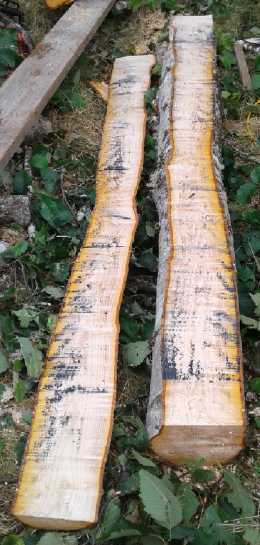
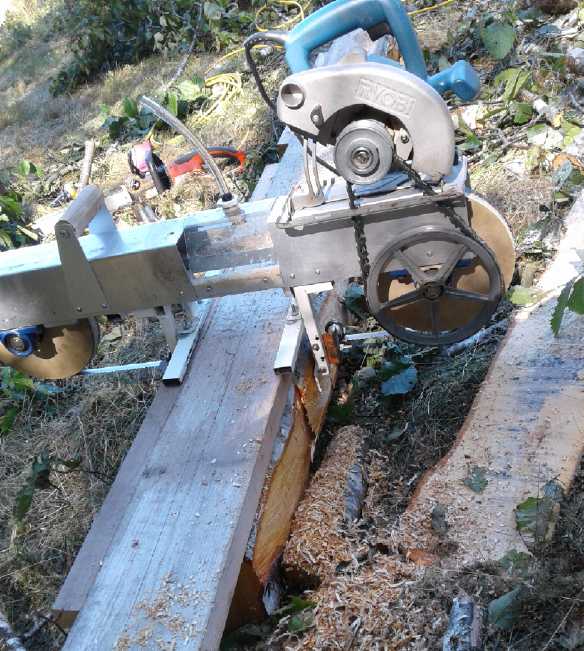
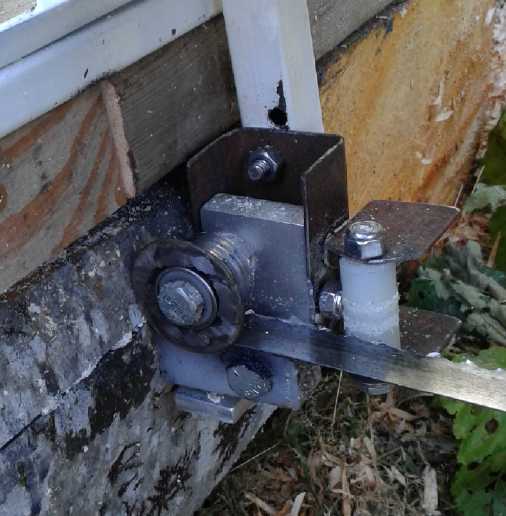
 15th: I sharpened the blade
using the diamond cylinder but in the
cordless drill at slow speeds instead of in the 'dremmel'. Then I
rubbed a candle on the band to wax it, which is an old sawing trick to
reduce blade friction that I suddenly remembered. It felt sharper
running my finger along it. I cut a board from the log. At first, where
the log was around 6" wide, it seemed to go a little better, but that
didn't last long and it became quite tedious again. It didn't help that
the guide board wasn't quite straight. And it was a little wider, up to
almost 9" instead of 6", so perhaps it was actually a little easier
cutting than spruce. For some reason I had a really hard time cutting
the last few inches, which was 9" wide, and it came out quite bowed
there. I still don't understand what the problem was. It was
frustrating enough that I didn't try cutting another one. I know
cutting was easier in January when the bands were new. I tried
sharpening the band on my shop bandsaw too, but it too still felt like
it was dull when I tried to cut with it. Was my sharpening not very
effective?
15th: I sharpened the blade
using the diamond cylinder but in the
cordless drill at slow speeds instead of in the 'dremmel'. Then I
rubbed a candle on the band to wax it, which is an old sawing trick to
reduce blade friction that I suddenly remembered. It felt sharper
running my finger along it. I cut a board from the log. At first, where
the log was around 6" wide, it seemed to go a little better, but that
didn't last long and it became quite tedious again. It didn't help that
the guide board wasn't quite straight. And it was a little wider, up to
almost 9" instead of 6", so perhaps it was actually a little easier
cutting than spruce. For some reason I had a really hard time cutting
the last few inches, which was 9" wide, and it came out quite bowed
there. I still don't understand what the problem was. It was
frustrating enough that I didn't try cutting another one. I know
cutting was easier in January when the bands were new. I tried
sharpening the band on my shop bandsaw too, but it too still felt like
it was dull when I tried to cut with it. Was my sharpening not very
effective? 16th: I finally couldn't stand having to have
the "skis" set to exactly
the width of the guide board. That wasn't so bad cutting from squared
cants, but it was a real nuisance with a log of varying width. I'd had
to screw pieces of 2"x2" onto the edge of the guide board and adjust
the "skis" outward to match, and even so, slice bits off the edges of
the log with the chainsaw. I cludged together a way to mount the same
"skis" crossways from the same "legs" and "feet" sticking out from the
bottom of the saw. I figured the rear one didn't have to be very far
back since the saw was cutting forward, but I stuck in some extensions
to the feet at the front. The bars going across (the former skis) had
specific holes, to which I added a couple. Some way to be able to slide
them for
setting the cut width would be much better, but this was what could be
worked in easily.
16th: I finally couldn't stand having to have
the "skis" set to exactly
the width of the guide board. That wasn't so bad cutting from squared
cants, but it was a real nuisance with a log of varying width. I'd had
to screw pieces of 2"x2" onto the edge of the guide board and adjust
the "skis" outward to match, and even so, slice bits off the edges of
the log with the chainsaw. I cludged together a way to mount the same
"skis" crossways from the same "legs" and "feet" sticking out from the
bottom of the saw. I figured the rear one didn't have to be very far
back since the saw was cutting forward, but I stuck in some extensions
to the feet at the front. The bars going across (the former skis) had
specific holes, to which I added a couple. Some way to be able to slide
them for
setting the cut width would be much better, but this was what could be
worked in easily. And I cut the right side guard
and swapped the short section
of it for the transparent section in order to be able to look down on
and monitor the 'in' side band guide and the blade protector. To my
surprise, I hadn't really moved it over as far as I expected. There was
only a couple of inches window out as far as the guide. What it was was
that the guide can be moved, and it was out at 9" instead of 6". It
should have a much longer transparent section to see it wherever it's
set. But then I found that a bit of sawdust built up on the plastic on
the inside. To see much after a short time it really needed a
windshield wiper, so it wasn't as useful as I'd expected.
And I cut the right side guard
and swapped the short section
of it for the transparent section in order to be able to look down on
and monitor the 'in' side band guide and the blade protector. To my
surprise, I hadn't really moved it over as far as I expected. There was
only a couple of inches window out as far as the guide. What it was was
that the guide can be moved, and it was out at 9" instead of 6". It
should have a much longer transparent section to see it wherever it's
set. But then I found that a bit of sawdust built up on the plastic on
the inside. To see much after a short time it really needed a
windshield wiper, so it wasn't as useful as I'd expected.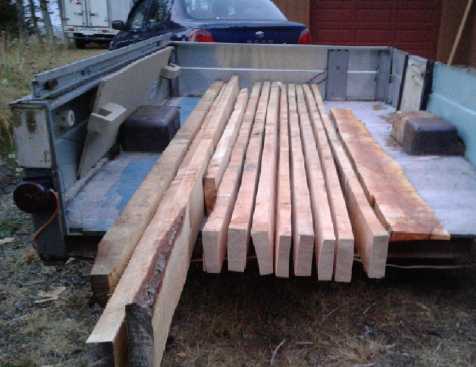
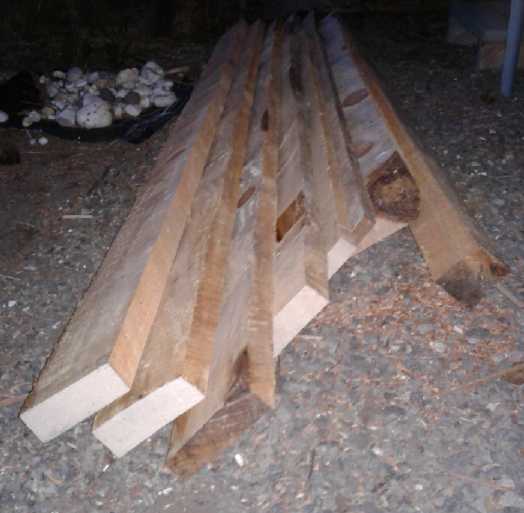
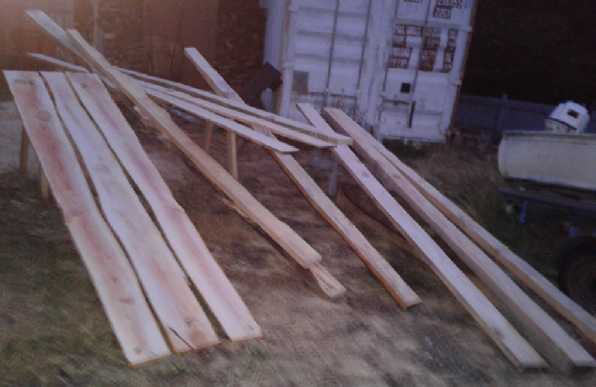
 I took it out
and cut a 5.5" wide board, 14 feet long and
1.25" thick. The super sharp new band definitely cut faster. It blazed
through 10 feet in pretty exactly one minute (of actual cutting time -
I stopped briefly three times, to look and put in a wedge, and to
reposition myself as it cut). I then cut two more 6-1/8" wide and 10
feet long. Even at just 5/8" wider they seemed to cut noticeably
slower, but still quite well and I timed the first one at about 90
seconds for the entire length, still over 6 feet per minute.
I took it out
and cut a 5.5" wide board, 14 feet long and
1.25" thick. The super sharp new band definitely cut faster. It blazed
through 10 feet in pretty exactly one minute (of actual cutting time -
I stopped briefly three times, to look and put in a wedge, and to
reposition myself as it cut). I then cut two more 6-1/8" wide and 10
feet long. Even at just 5/8" wider they seemed to cut noticeably
slower, but still quite well and I timed the first one at about 90
seconds for the entire length, still over 6 feet per minute. 30th: It looked like it
would rain. I cut seven more ~6" wide boards
totaling 72' length in the morning in about an hour and a half. Part of
that time was spent cutting the several scraps that became too thin to
make more boards into firewood and carting them to the firewood shed.
However, each board seemed to take incrementally longer to cut until
the last one was below 5 feet/minute. At the same time it became
incrementally harder to push the saw. The harder I pushed, the more
likely the rear skid, or one side or the other, was to lift away from
the guide board. This of course cut curves in the otherwise seemingly
pretty straight cuts and made still more friction. Now that I was
cutting enough wood at a time to start feeling the difference I
recognized that gradually dulling bands had been another part of my
problems. Or at least I thought so... but it turned out there was a
reason they dulled so fast.
30th: It looked like it
would rain. I cut seven more ~6" wide boards
totaling 72' length in the morning in about an hour and a half. Part of
that time was spent cutting the several scraps that became too thin to
make more boards into firewood and carting them to the firewood shed.
However, each board seemed to take incrementally longer to cut until
the last one was below 5 feet/minute. At the same time it became
incrementally harder to push the saw. The harder I pushed, the more
likely the rear skid, or one side or the other, was to lift away from
the guide board. This of course cut curves in the otherwise seemingly
pretty straight cuts and made still more friction. Now that I was
cutting enough wood at a time to start feeling the difference I
recognized that gradually dulling bands had been another part of my
problems. Or at least I thought so... but it turned out there was a
reason they dulled so fast. I
started to think it might be a good idea to at least
finish the improved Piggott alternator I had started in the months just
before I moved - early 2017. I found I didn't have any more sets of
unused 1" x 2" x .5' magnets. (Lots of 1" x 2" x 3/8" ones for Electric
Hubcap motors.) But I had a previously set of 12, some more used ones
and 4 new ones all of
the same type that made 23 (#24 was corroded), and I used a different
brand for #24. On the 30th I cleaned the epoxy off the set of 12 and
wire brushed the rust off one of the custom CNC waterjet
cut rotors. On the 31st I found and cleaned the other 12 and brushed
off
another rotor, then I mixed a bit of epoxy, painted it onto a rotor,
and set the first 12 magnets in place.
I
started to think it might be a good idea to at least
finish the improved Piggott alternator I had started in the months just
before I moved - early 2017. I found I didn't have any more sets of
unused 1" x 2" x .5' magnets. (Lots of 1" x 2" x 3/8" ones for Electric
Hubcap motors.) But I had a previously set of 12, some more used ones
and 4 new ones all of
the same type that made 23 (#24 was corroded), and I used a different
brand for #24. On the 30th I cleaned the epoxy off the set of 12 and
wire brushed the rust off one of the custom CNC waterjet
cut rotors. On the 31st I found and cleaned the other 12 and brushed
off
another rotor, then I mixed a bit of epoxy, painted it onto a rotor,
and set the first 12 magnets in place.
 I etched the
zinc strip for about 20 seconds in ferric
chloride to increase nano-scale surface roughness. I didn't do anything
to the lead. I'm not sure what might help. Previously I had rolled the
sheets thinner using a
textured roller in the rolling mill, also trying to get more surface
roughness.
I etched the
zinc strip for about 20 seconds in ferric
chloride to increase nano-scale surface roughness. I didn't do anything
to the lead. I'm not sure what might help. Previously I had rolled the
sheets thinner using a
textured roller in the rolling mill, also trying to get more surface
roughness. Being about out of watercolor paper, I got some parchment
paper from a kitchen drawer (from a grocery) and cut a long strip. I
folded it in a "V" over the lead. As I tried to roll it up it kept
moving over to the outside and I had to keep crinkling it to keep it in
line. The zinc was 82 grams before etching and I forgot to weigh it
after. The whole with the lead, zinc and paper weighed just a little
over 500 grams. (Ugh - If you don't write it down right away, you
forget exact figures.) It it didn't seem to fit into a '1.25"' (really
about 1.4") PVC irrigation pipe. It almost fit in a 1.5" ABS pipe, but
not quite.
Being about out of watercolor paper, I got some parchment
paper from a kitchen drawer (from a grocery) and cut a long strip. I
folded it in a "V" over the lead. As I tried to roll it up it kept
moving over to the outside and I had to keep crinkling it to keep it in
line. The zinc was 82 grams before etching and I forgot to weigh it
after. The whole with the lead, zinc and paper weighed just a little
over 500 grams. (Ugh - If you don't write it down right away, you
forget exact figures.) It it didn't seem to fit into a '1.25"' (really
about 1.4") PVC irrigation pipe. It almost fit in a 1.5" ABS pipe, but
not quite. Then I cut a length of the 1.5" ABS pipe and "glued" a
flat (white) piece on one end for a bottom. I left it a while to set,
then
filled it with water. It didn't seem to leak.
Then I cut a length of the 1.5" ABS pipe and "glued" a
flat (white) piece on one end for a bottom. I left it a while to set,
then
filled it with water. It didn't seem to leak. On the evening
of the 24th I thought better of it, and
having had no time for any other experiments or project work, I
unrolled the cell. Even when it was completely unrolled it was still
shorted. The parchment paper looked good except where I had
accidentally ripped it in the unrolling. Only when I separated the
sheets and then laid one "X" across the other did the voltage start to
rise. to about .3 volts. I never did find the short. There were black
oxides stuck to all four sides of the paper. I shrugged and rolled it
up again with a new strip of parchment paper. This time I folded it
over the zinc instead of the lead (as if that should make any
difference). And I added an extra layer just in the middle. It fit back
in its "can" and I connected the power.
On the evening
of the 24th I thought better of it, and
having had no time for any other experiments or project work, I
unrolled the cell. Even when it was completely unrolled it was still
shorted. The parchment paper looked good except where I had
accidentally ripped it in the unrolling. Only when I separated the
sheets and then laid one "X" across the other did the voltage start to
rise. to about .3 volts. I never did find the short. There were black
oxides stuck to all four sides of the paper. I shrugged and rolled it
up again with a new strip of parchment paper. This time I folded it
over the zinc instead of the lead (as if that should make any
difference). And I added an extra layer just in the middle. It fit back
in its "can" and I connected the power.